This class describes the building of fields on multiscale centered dioptic grids initialized by the initialize() method. More...
#include <EMM_MultiScaleCDGrid.h>
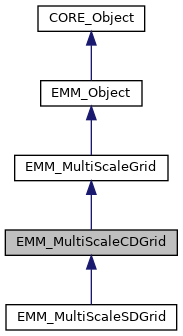
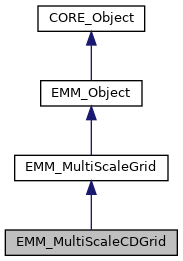
Public Member Functions | |
| EMM_MultiScaleCDGrid (void) | |
| create More... | |
| virtual | ~EMM_MultiScaleCDGrid (void) |
| destroy More... | |
| virtual void | initialize (const tDimension &dim, const tUInteger &Nx, const tUInteger &Ny, const tUInteger &Nz, const tBoolean &Px, const tBoolean &Py, const tBoolean &Pz, const tUInteger &l) |
| set the discretization More... | |
| void | meanValuesFromFineToCoarseGrid (const tUIndex &nCells, const tDimension &dim, const tReal *Mf, tReal *Ml) const |
| compute the field in a corse field from its fine grid. More... | |
| void | completeValuesOutsideFineGridByPeriodicity (const tUIndex &nCells, const tDimension &dim, tReal *Ml) const |
| complete the values of the field in the coarse grid is set from its values in its included fine grid by periodicity More... | |
| tBoolean | resetValuesWithinCenteredZone (const tUIndex &nCells, const tDimension &dim, tReal *Mz) const |
| void | addValuesFromCoarseGridToFinestGrid (const tUIndex &nCells, const tDimension &dim, const tUInteger &twoPowerL, const tReal *Ml, tReal *Mf) const |
add the value of the field defined in coarse grid  bigger than its finest grid into the field defined in its finest grid More... bigger than its finest grid into the field defined in its finest grid More... | |
| void | setToeplitzMatrix (SP::MATH_MultiLevelsToeplitzMatrix toeplitz) |
| setthe toeplitz associated matrix More... | |
| tUInteger | computeLevelsNumber (const tUInteger &Nx, const tUInteger &Ny, const tUInteger &Nz, const tBoolean &isXPeriodic, const tBoolean &isYPeriodic, const tBoolean &isZPeriodic) const |
| compute the optimal levels number More... | |
| const tUCInt & | getFineElementsNumberPerCoarseElement () const |
| get the number of elements of the fine grid per cell of the corse grid More... | |
| void | getSegmentsNumber (tUInteger &Nx, tUInteger &Ny, tUInteger &Nz) const |
| get the segments number in all directions More... | |
| const tUInteger * | getSegmentsNumber () const |
| get the segments number per dierction More... | |
| const tBoolean * | getPeriodicDirections () const |
| get the periodicity per direction More... | |
| void | getPeriodicDirections (tBoolean &isXPeriodic, tBoolean &isYPeriodic, tBoolean &isZPeriodic) const |
| get the periodicity per direction More... | |
| const tUInteger & | getLevelsNumber () const |
| get the leves number More... | |
| const MATH_MultiLevelsToeplitzMatrix & | getToeplitzMatrix () const |
| get the toeplitz matrix More... | |
| EMM_RealField & | getLevelMagnetizationField () |
| get the magnetization field at level l More... | |
| EMM_RealField & | getLevelUpMagnetizationField () |
| get the magnetization field at level l+1 More... | |
| EMM_RealField & | getZonalMagnetizationField () |
| get the magnetization field at zone More... | |
| virtual void | computeMultiGridExcitationField (const tUIndex &nCells, const tDimension &dim, const tReal *sigmaM, tReal *H) |
| compute the magnetic excitation field by superposition of multi scale grids More... | |
| virtual tString | toString () const |
| return the class information in a tString More... | |
| void | getSharedPointer (SP::CORE_Object &p) |
| get the shared pointer of this class into p More... | |
| void | getSharedPointer (SPC::CORE_Object &p) const |
| get the shared pointer of this class into p More... | |
| tString | getClassName () const |
| return the class name of the object More... | |
| tString | getIdentityString () const |
| return the identity string of the object of the form className_at_address More... | |
| tString | getPointerAddress () const |
| return the identity string of the object More... | |
| template<class T > | |
| tBoolean | isInstanceOf () const |
| test if the clas T is an instance of this class More... | |
| tBoolean | isInstanceOf (const tString &name) const |
| test if the object is an instance of className More... | |
Static Public Member Functions | |
| static SP::EMM_MultiScaleCDGrid | New () |
| build a new instance of class More... | |
| static tBoolean | resetBlockValues (const tDimension &dim, const tUInteger &Nx, const tUInteger &Ny, const tUInteger &Nz, const tUInteger &iMin, const tUInteger &iMax, const tUInteger &jMin, const tUInteger &jMax, const tUInteger &kMin, const tUInteger &kMax, tReal *M) |
| reset the values in a block grid [iMin,iMax[x[jMin,jMax[x[kMin,kMax[ of dimension dim per point inside a grid of size [0,Nx[x[0,Ny[x[0,Nz[ More... | |
| static void | setIsMemoryChecked (const tBoolean &v) |
| set if the memory checking is used More... | |
| static void | setOut (SP::CORE_Out out) |
| set the output stream More... | |
| static void | resetOut () |
| reset the output stream More... | |
| static void | setThread (SP::CORE_Thread thread) |
| set the thread More... | |
| static void | resetThread () |
| reset the output stream More... | |
| static CORE_Out & | out () |
| get the output More... | |
| static SP::CORE_Out | getOut () |
| get the output More... | |
| static CORE_Thread & | getThread () |
| get the profilier More... | |
| static const tBoolean & | isMemoryChecked () |
| get if the memory checking is used More... | |
| static tString | getClassName (const tString &identityString) |
| return the class name of the object More... | |
| template<class T > | |
| static tString | getTypeName () |
| get type name More... | |
| static tBoolean | is64Architecture () |
| return true if the machine is a 64 bits machine More... | |
| static tBoolean | is32Architecture () |
| return true if the machine is a 32 bits machine More... | |
| static tString | pointer2String (const void *obj) |
| return the string representation of a pointer More... | |
| static void | printObjectsInMemory (ostream &f) |
| print object in memory More... | |
| static void | printObjectsInMemory () |
| print object in memory in the standart output More... | |
| static tChar | getMaxChar () |
| get the max value for tChar type More... | |
| static tChar | getMinChar () |
| get the min value for tChar type More... | |
| static tUChar | getMaxUChar () |
| get the max value for tUChar type More... | |
| static tUChar | getMinUChar () |
| get the min value for tUChar type More... | |
| static tSInt | getMaxSInt () |
| get the max value for tSInt type More... | |
| static tSInt | getMinSInt () |
| get the min value for tSInt type More... | |
| static tUSInt | getMaxUSInt () |
| get the max value for tUSInt type More... | |
| static tUSInt | getMinUSInt () |
| get the min value for tUSInt type More... | |
| static tInt | getMaxInt () |
| get the max value for tInt type More... | |
| static tInt | getMinInt () |
| get the min value for tInt type More... | |
| static tUInt | getMaxUInt () |
| get the max value for tUInt type More... | |
| static tUInt | getMinUInt () |
| get the min value for tUInt type More... | |
| static tLInt | getMaxLInt () |
| get the max value for tLInt type More... | |
| static tLInt | getMinLInt () |
| get the min value for tLInt type More... | |
| static tULInt | getMaxULInt () |
| get the max value for tULInt type More... | |
| static tULInt | getMinULInt () |
| get the min value for tULInt type More... | |
| static tLLInt | getMaxLLInt () |
| get the max value for tULInt type More... | |
| static tLLInt | getMinLLInt () |
| get the min value for tLLInt type More... | |
| static tULLInt | getMaxULLInt () |
| get the max value for tULLInt type More... | |
| static tULLInt | getMinULLInt () |
| get the min value for tULLInt type More... | |
| static tFloat | getMaxFloat () |
| get the max value for tFloat type More... | |
| static tFloat | getMinFloat () |
| get the min value for tFloat type More... | |
| template<class T > | |
| static T | getEpsilon () |
| get the epsilon value for T type More... | |
| template<class T > | |
| static T | getInfinity () |
| get the infinity for T type More... | |
| static tFloat | getFloatEpsilon () |
| get the epsilon value for tFloat type More... | |
| static tFloat | getFloatInfinity () |
| get the infinity value for tFloat type More... | |
| static tDouble | getMaxDouble () |
| get the max value for tDouble type More... | |
| static tDouble | getMinDouble () |
| get the min value for tDouble type More... | |
| static tDouble | getDoubleInfinity () |
| get the infinity value for tFloat type More... | |
| static tDouble | getDoubleEpsilon () |
| get the epsilon value for tDouble type More... | |
| static tLDouble | getMinLDouble () |
| get the min value for tLDouble type More... | |
| static tLDouble | getMaxLDouble () |
| get the max value for tLDouble type More... | |
| static tLDouble | getLDoubleEpsilon () |
| get the epsilon value for tLDouble type More... | |
| static tDouble | getLDoubleInfinity () |
| get the infinity value for tDouble type More... | |
| static tIndex | getMaxIndex () |
| get the max value for the array/vector indexing type More... | |
| static tIndex | getMinIndex () |
| get the min value for the array/vector indexing type More... | |
| static tUIndex | getMaxUIndex () |
| get the max value for difference the array/vector indexing type More... | |
| static tUIndex | getMinUIndex () |
| get the min value for difference the array/vector indexing type More... | |
| static tFlag | getMaxFlag () |
| get the max value for the tFlag type More... | |
| static tFlag | getMinFlag () |
| get the min value for the tFlag type More... | |
| static tUInteger | getMaxUInteger () |
| get the max value for the unsigned integer type More... | |
| static tUInteger | getMinUInteger () |
| get the min value for the unsigned integer type More... | |
| static tInteger | getMaxInteger () |
| get the max value for the integer type More... | |
| static tInteger | getMinInteger () |
| get the min value for the integer type More... | |
| static tReal | getMaxReal () |
| get the max value for the real type More... | |
| static tReal | getMinReal () |
| get the min value for the real type More... | |
| static tReal | getRealEpsilon () |
| get the eps which is the difference between 1 and the least value greater than 1 that is representable. More... | |
| static tReal | getRealInfinity () |
| get the infinity value More... | |
| template<class T > | |
| static T | computeEpsilon () |
| compute epsilon More... | |
Static Public Attributes | |
| static tBoolean | SAVE_H_M_AT_LEVEL_1 =false |
| static const tReal | Mu0 =4*M_PI*1e-07 |
| static const tReal | Gamma =-1.7e11 |
| static const tDimension | X =0 |
| static const tDimension | Y =1 |
| static const tDimension | Z =2 |
| static const tReal | NULL_VALUE [] ={0,0,0} |
Protected Member Functions | |
| virtual void | computeZonalDemagnetizedFieldAndNextLevelMagnetizationField (const tUInteger &twoPowerL, const tUIndex &nCells, const tDimension &dim, const tReal *Ml, tReal *Mz, tReal *Mlp1, tReal *H0) const |
| compute the zonal demagnetized field added to demagnetized field at level 0 and compute the magnetization field at level l+1 More... | |
| virtual void | computeZonalCenteredDemagnetizedFieldFromLevel (const tUInteger &twoPowerL, const tUIndex &nCells, const tDimension &dim, tReal *Ml, tReal *Mz, tReal *H0) const |
| compute the centered demagnetized field of level l outside zone anad add it to demagnetized field at level 0 More... | |
| tUInteger & | getLevelComputationsNumber () |
| return the number of calls of the level computations only for debug More... | |
| const tUInteger & | getLevelComputationsNumber () const |
| return the number of calls of the level computations only for debug More... | |
| virtual void | toDoAfterThisSetting () |
| method called after the setting of the shared pointer this method can only be called once. More... | |
| void | setThis (SP::CORE_Object p) |
| set this weak shared pointer called toDoAfterThis setting method More... | |
Private Member Functions | |
| SP_OBJECT (EMM_MultiScaleCDGrid) | |
| void | completeValuesOutsideFineGridByPeriodicityByExclusion (const tUIndex &nCells, const tDimension &dim, tReal *Ml) const |
| complete the values of the field in the coarse grid is set from its values in its included fine grid by periodicity More... | |
| void | computeMagnetizationFieldAtNextLevel (const tUIndex &nCells, const tDimension &dim, const tReal *Ml, tReal *Mlp1) const |
| compute the magntization field at level l+1 for field at level l More... | |
| void | computeDemagnetizedExcitationFieldFromLevel (const tUInteger &twoPowerL, const tUIndex &nCells, const tDimension &dim, tReal *Ml, tReal *H0) const |
| compute the magnetic exitation of the grid at level l and add it to the magnetic excitation field of level 0 More... | |
Detailed Description
This class describes the building of fields on multiscale centered dioptic grids initialized by the initialize() method.
- to enlarge the field from a fine grid to a large grid, see meanValuesFromFineToCoarseGrid(), and completeValuesOutsideFineGridByPeriodicity() methods.
- to reset the value of a field defined on a large grid on cells which has intersection with the finest grid see resetValuesWithinCenteredZone() method.
- to add the field value defined on a large
 grid to the values of the field only on the finest grid see addValuesFromCoarseGridToFinestGrid() method.
grid to the values of the field only on the finest grid see addValuesFromCoarseGridToFinestGrid() method.
For building centered dyotic coarse grids, the number of segments in each direction must be 1 or a pair number.
For computing the magnetic excitation field for periodic domain, a sequence of l-dyotic grids is built: the grid of level l is included into the grid of level l+1. The grid of level l+1 is twice size of the grid of level l in each direction. The total magnetic excitation field is built as follow see computeMultiGridExcitationField() :
- compute H0 based on the magnetization field M into the 0-level of the domain
- within the common part of the coarse grid (level l+1) and the fine grid (level l), M at level l+1 is set to the mean of M at level l from the fine grid
- in the part within the coarse grid outside the fine grid, the magnetization M at level l+1 is set by periodicity to the value of M at level l on its corresponding periodic element within the common part of the coarse grid and fine grid (or set to 0 if no periodicity on the direction)
- the magnetic excitation contribution of the coarse grid is computed by the magnetization field M at level l+1 which is null on common cells between the coarse and the fine grids. Note that the toeplitz matrix for each level are the same because all cells of the grids have the same geometry.
- the magnetic excitation fields of all levels are added to H0 to build the total demagnetized excitation magnetic field over the grid at the level 0
the number of levels is set to 1 for non periodic domain. the number of levels of periodic domain must be at least 2
To compute the demagnetized magnetic excitation field in a grid 4x4x1 with peridicity on x & y.
| Step 1 |  |
M at level l |
| Step 2 | 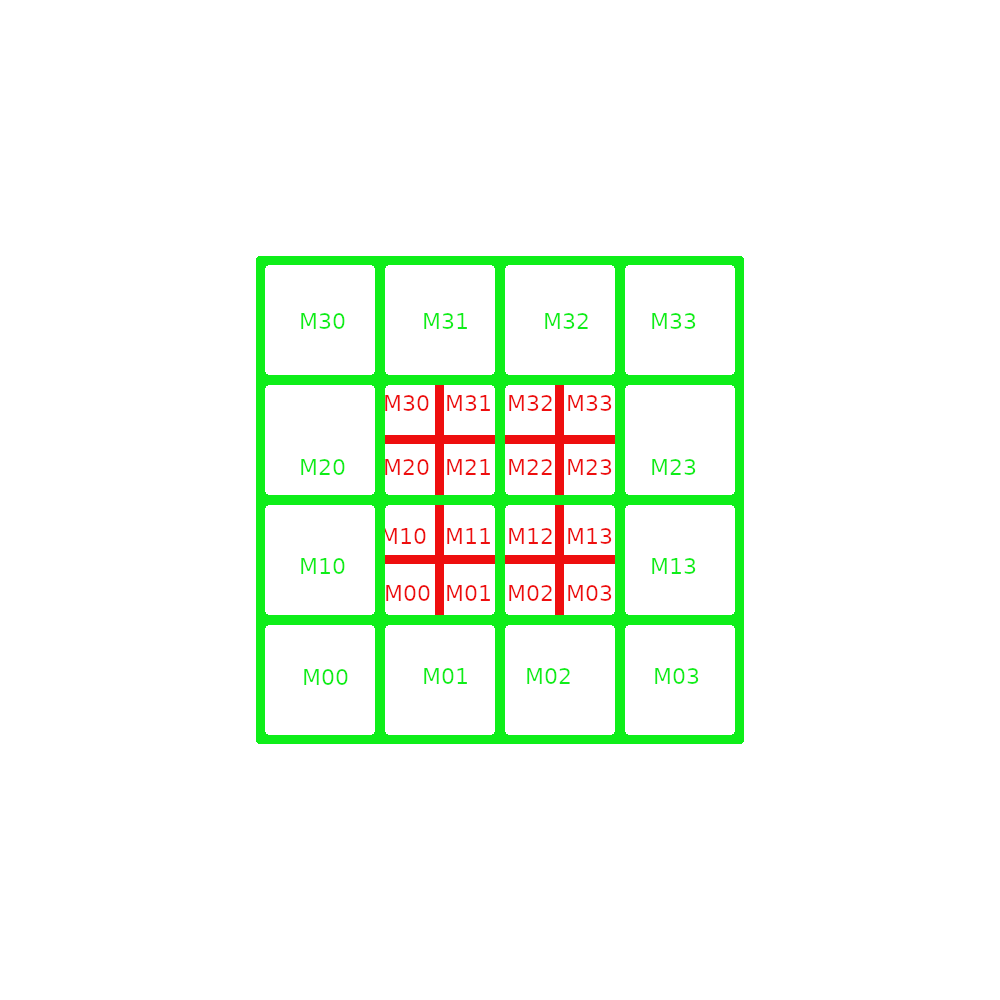 |
M at level l+1 |
the values of the field  is meaned in the common part of the both grids as follow:
is meaned in the common part of the both grids as follow:
because of periodicity the value of the magnetization ouside the fine grid is for the x periodicity:
and for the y periodicity (if there is periodicity on y, 0 otherwise) we have:
| Step 3 | 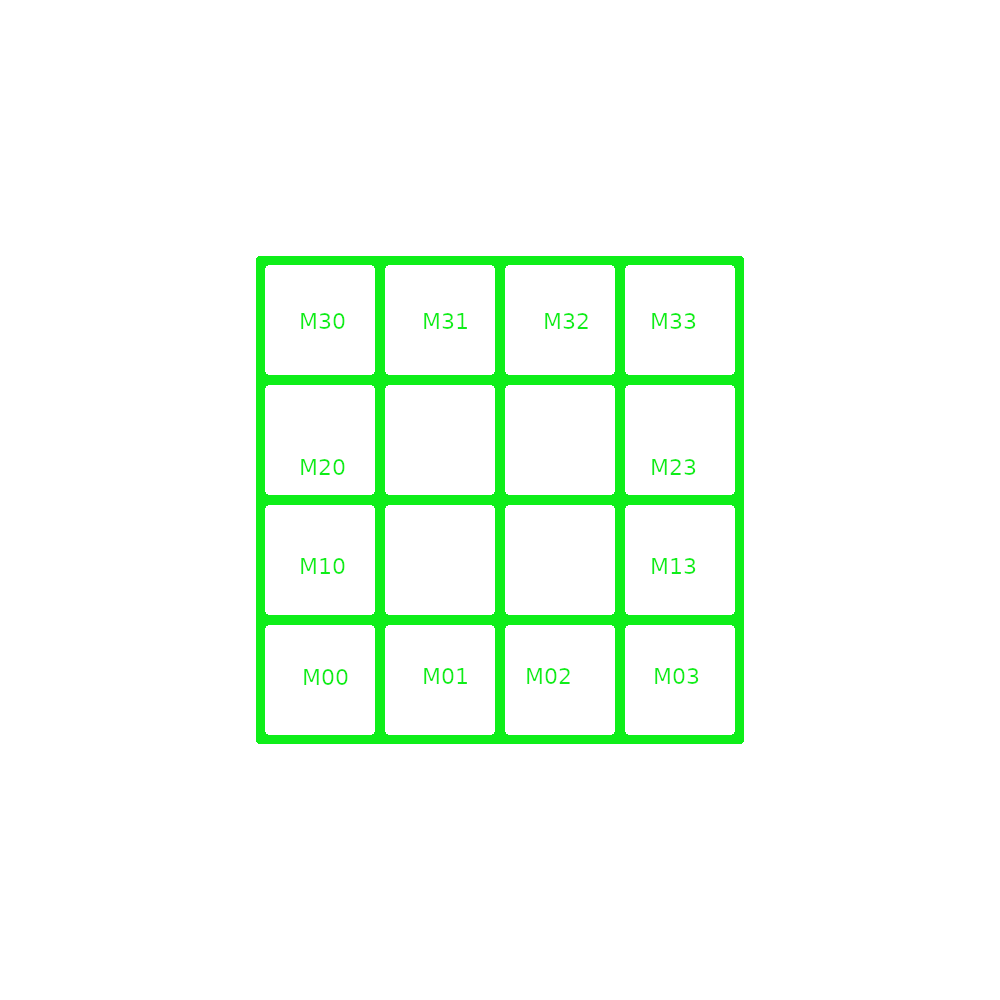 |
Mh for computing magnetic excitation contribution of level l+1 |
To compute the contribution of magnetic excitation field of the level l+1 over the grid at level 0 , M is set to 0 on common cells between grid at level l and at level l+1  and
and
Then, the magnetic excitation at level l+1 is  is computed for all levels
is computed for all levels 
Then, the magnetic excitation is  over the grid at level 0 .
over the grid at level 0 .
| Step 4 | 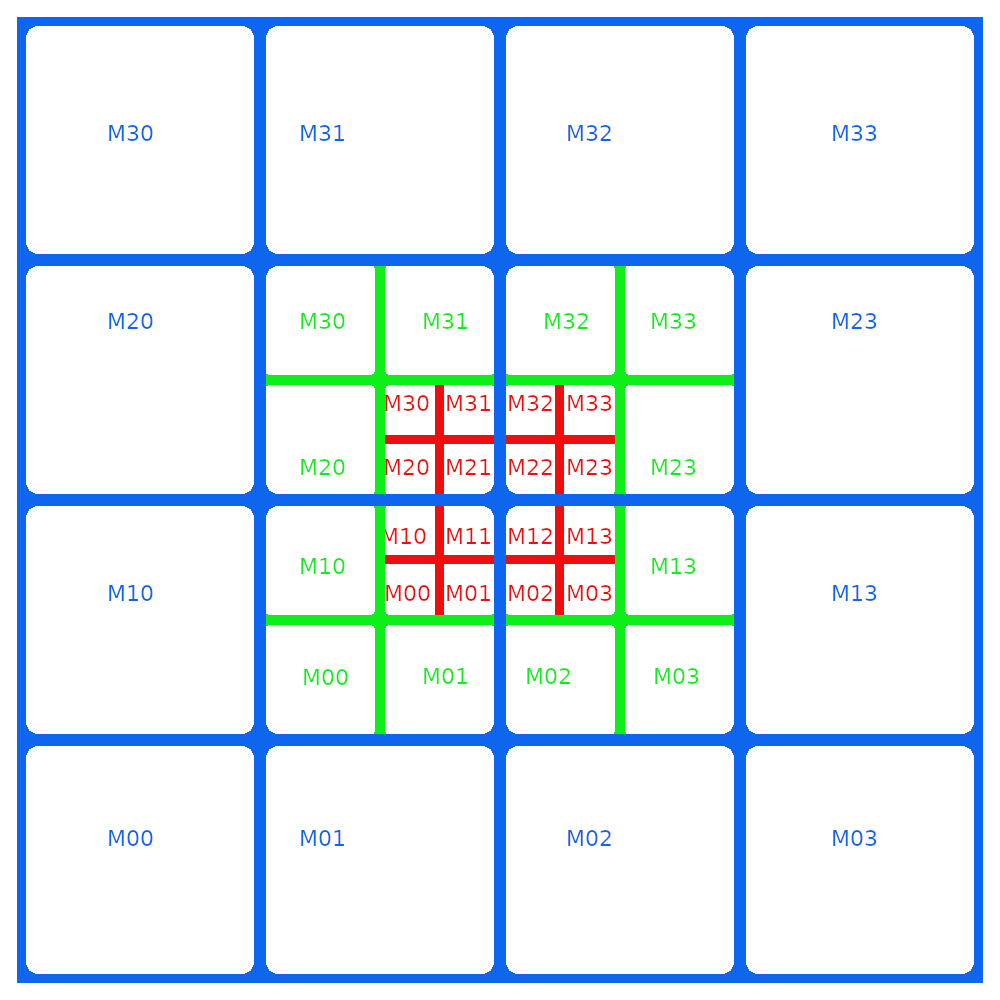 |
go to the step 1 for next level |
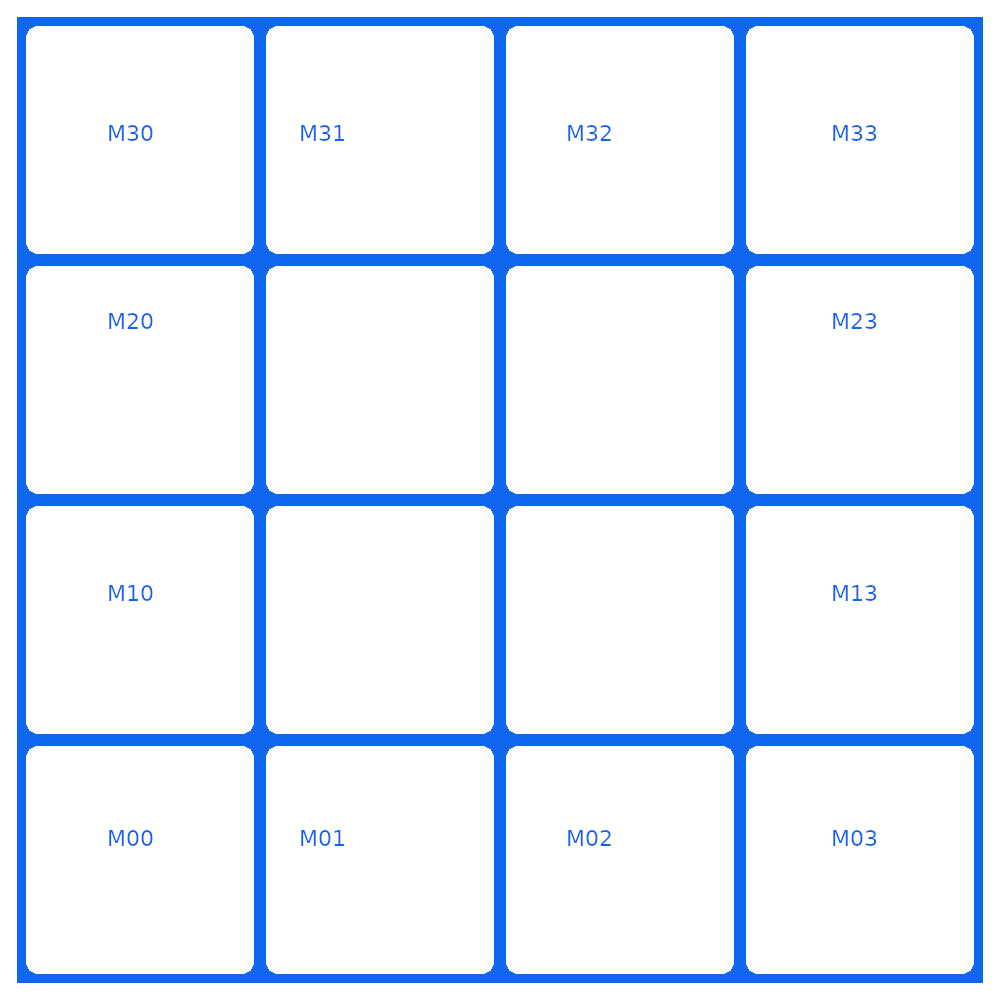 |
to compute the contribution of the next periodic cells |
Note that this algorithm is not valid if the number of segments in only pair (such as N=2 for example). Consider the fine grid as a periodical to compute the mean of the magnetization inside the coarse grid:
For example, consider N=6 at first level with the magnetized field :
| 1 | 2 | 3 | 4 | 5 | 6 | -> H0
By periodicity the mean is as follow:
| | 7/2 | 5/2 | 9/2 | 7/2 | |
and then the magnetization at next level is as follow:
| 7/2 | 7/2 | 5/2 | 9/2 | 7/2 | 7/2 |
So to compute H1, the magnetization field is turned into :
| 7/2 |x 0 | 0 | 0 |0 x | 7/2 | -> H1
But the part of the x set to 0 is forgotten in H0 and H1...
To remains valid all the cells in common of the grid the level l+1 and l must be equal to the union of cells at level l.
- Version
- 1.0
Constructor & Destructor Documentation
◆ EMM_MultiScaleCDGrid()
| EMM_MultiScaleCDGrid::EMM_MultiScaleCDGrid | ( | void | ) |
◆ ~EMM_MultiScaleCDGrid()
|
virtual |
destroy
Member Function Documentation
◆ addValuesFromCoarseGridToFinestGrid()
| void EMM_MultiScaleCDGrid::addValuesFromCoarseGridToFinestGrid | ( | const tUIndex & | nCells, |
| const tDimension & | dim, | ||
| const tUInteger & | twoPowerL, | ||
| const tReal * | Ml, | ||
| tReal * | Mf | ||
| ) | const |
add the value of the field defined in coarse grid  bigger than its finest grid into the field defined in its finest grid
bigger than its finest grid into the field defined in its finest grid
- Parameters
-
[in] nCells number of elements of the field [in] dim dimension of the field [in] twoPowerL : step size of the coarse grid with respect of the finest grid [in] Ml : the large field values of size dim . Nx . Ny . Nz [in,out] Mf : the fine field values of size dim . Nx . Ny . Nz
add the value of the field Ml to the value of the field Mf on the cells in common.
For each cell of the finest grid, the corresponding cell of the coarse grid is computed and the values of the field at the coarse element is added to the value of the field at the fine element.
The corresponding coarse elements to the element from the fine grid is computed such that the coarse element contains the center of the element of the fine grid by the following relation.
For each element (i,j,k) of the grid at level 0, the corresponding element (I(i),J(j),K(k)) of the grid at level l is searched such that the center of the element (i,j,k) of the grid at level 0 is inside the element (I,J,K) of the grid at level l.
The left boundary of the grid at level l is  when the origin is at the center of the grid
when the origin is at the center of the grid
The center of the grid at level 0 is  when the origin is at the center of the grid
when the origin is at the center of the grid
So, to search the cell of the grid at level l containing the center of the grid at level 0 leads to  . We conclude that
. We conclude that


 .
.
References EMM_MultiScaleGrid::getLevelComputationsNumber(), EMM_MultiScaleGrid::getSegmentsNumber(), null, OMP_GET_THREAD_ID, OMP_GET_THREADS_NUMBER, OMP_PARALLEL_PRIVATE_SHARED_DEFAULT, EMM_Output::saveVTI(), tDimension, CORE_Integer::toString(), tReal, tUIndex, and tUInteger.
Referenced by completeValuesOutsideFineGridByPeriodicity(), and computeDemagnetizedExcitationFieldFromLevel().


◆ completeValuesOutsideFineGridByPeriodicity()
|
inline |
complete the values of the field in the coarse grid is set from its values in its included fine grid by periodicity
- Parameters
-
[in] nCells number of elements of the mesh [in] dim dimension of the field [in,out] Ml : the coarse field values of size dim . nCells
| Step 1 |  |
M at level l |
| Step 2 |  |
M at level l+1 |
If there is periodicity on x, we have:
If there is periodicity on y, we have:




If there is periodicity on x and y, we have in addition:




References addValuesFromCoarseGridToFinestGrid(), completeValuesOutsideFineGridByPeriodicityByExclusion(), resetValuesWithinCenteredZone(), tBoolean, tDimension, tReal, tUIndex, and tUInteger.
Referenced by computeMagnetizationFieldAtNextLevel().


◆ completeValuesOutsideFineGridByPeriodicityByExclusion()
|
private |
complete the values of the field in the coarse grid is set from its values in its included fine grid by periodicity
- Parameters
-
[in] nCells number of elements of the mesh [in] dim dimension of the field [in,out] Ml : the coarse field values of size dim . nCells
| Step 1 |  |
M at level l |
| Step 2 |  |
M at level l+1 |
If there is periodicity on y, we have:




If there is periodicity on x and y, we have in addition:




loop all elements of the coarse grid.
- If there is an intersection with the fine grid, the element is ignored
- othersize, the element of the coarse grid with not null intersection with the fine grid is found by periodicity
References EMM_MultiScaleGrid::getPeriodicDirections(), EMM_MultiScaleGrid::getSegmentsNumber(), OMP_GET_THREAD_ID, OMP_GET_THREADS_NUMBER, OMP_PARALLEL_PRIVATE_SHARED_DEFAULT, tBoolean, tDimension, tReal, tUIndex, and tUInteger.
Referenced by completeValuesOutsideFineGridByPeriodicity().


◆ computeDemagnetizedExcitationFieldFromLevel()
|
private |
compute the magnetic exitation of the grid at level l and add it to the magnetic excitation field of level 0
- Parameters
-
[in] twoPowerL : ratio size of the grid at level l [in] nCells : number of cells of the mesh [in] dim dimension of each point of the mesh [in,out] Ml magnetization values of size nCells x dim at level L [in,out] H0 : demagnetized excitation field at level l
- reset the magnetization M0 on cells of the coarse grid at level l which are included in its fine grid at level l-1
- computes H=Hd(M0)
- add H to H0 from the level 0
References addValuesFromCoarseGridToFinestGrid(), EMM_MultiScaleGrid::getLevelComputationsNumber(), EMM_MultiScaleGrid::getSegmentsNumber(), EMM_MultiScaleGrid::getToeplitzMatrix(), resetValuesWithinCenteredZone(), EMM_Output::saveVTI(), CORE_Integer::toString(), tReal, tUInteger, and MATH_MultiLevelsToeplitzMatrix::vectorProduct().
Referenced by computeZonalCenteredDemagnetizedFieldFromLevel().
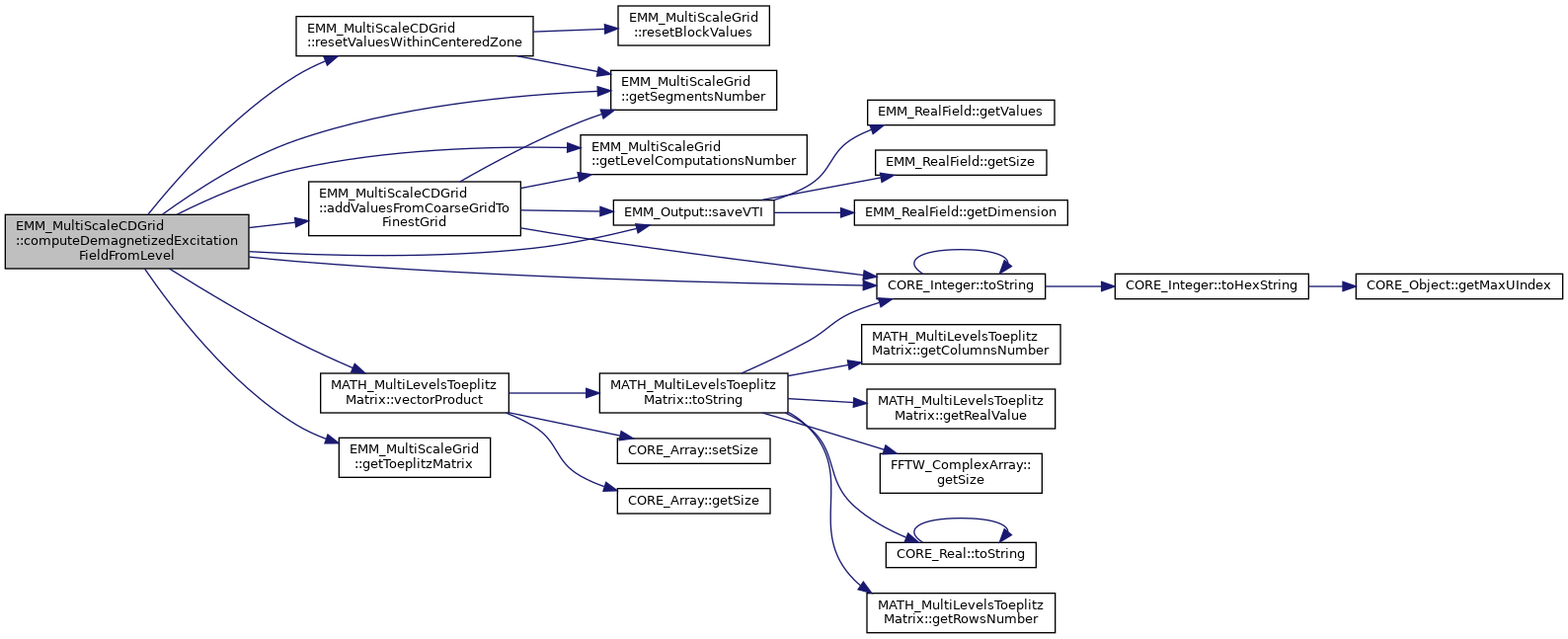

◆ computeEpsilon()
|
inlinestaticinherited |
compute epsilon
- Returns
- the epsilon value eps=10^{-p/3} where p is defined by getEpsilon()=10^{-p}
◆ computeLevelsNumber()
|
inherited |
compute the optimal levels number
- Parameters
-
Nx number of segments along x-direction Ny number of segments along y-direction Nz number of segments along z-direction isXPeriodic true if the x-direction is periodic isYPeriodic true if the y-direction is periodic isZPeriodic true if the z-direction is periodic
The level number per direction  is such that if
is such that if  If the domain is not periodic the level number is 0
If the domain is not periodic the level number is 0
- Returns
- the minimum of the level number for all directions
References CORE_Object::getMaxUInteger(), tBoolean, tUInteger, and tUSInt.
Referenced by EMM_MultiScaleGrid::setToeplitzMatrix().


◆ computeMagnetizationFieldAtNextLevel()
|
private |
compute the magntization field at level l+1 for field at level l
- Parameters
-
[in] nCells : number of cells of the mesh [in] dim dimension of each point of the mesh [in] Ml magnetization values of size nCells x dim at level l [out] Mlp1 : magnetization values of size nCells x dim at level l+1
- computes the mean values of M at each cell of the grid at level l+1 from all its included cells from its fine grid at level l
- computes the values of M at each call of the grid at level l+1 with no intersection with its fine grid at level l
References completeValuesOutsideFineGridByPeriodicity(), and meanValuesFromFineToCoarseGrid().
Referenced by computeZonalCenteredDemagnetizedFieldFromLevel(), and computeZonalDemagnetizedFieldAndNextLevelMagnetizationField().


◆ computeMultiGridExcitationField()
|
virtualinherited |
compute the magnetic excitation field by superposition of multi scale grids
- Parameters
-
[in] nCells : number of cells of the mesh [in] dim dimension of each point of the mesh [in] sigmaM magnetization values of size nCells x dim not necessarly normalized : sigmaM=sigma.M [out] H return excitation magnetic values of size nCells x dim
The following algorithm needs 3 temporary fields  ,
,  and
and  for computing by zone
for computing by zone
Computes the magnetic excitation field as follow:
- l=0
- computes H corresponding to sigma.M
 see MATH_ToeplitzMatrix::vectorProduct()
see MATH_ToeplitzMatrix::vectorProduct() - l=1, computeZonalDemagnetizedFieldAndNextLevelMagnetizationField() :
- add the contribution of the demagnetized field within shift zonal grids from level 0 into the demagnetized field at level 0
- builds M for level 1 by interpolation of M at level 0
- for all l in [1,L[
- computeZonalDemagnetizedFieldAndNextLevelMagnetizationField() :
- add the contribution of the demagnetized field within shift zonal grids from level l into the demagnetized field at level 0
- builds M for level l+1 by interpolation of M at level l
- computeZonalCenteredDemagnetizedFieldFromLevel()
- add the contribution of the demagnetized fiel at level l within centered coarse grid exculed shift zonal grid z into the demagnetized field at level 0 in zone z
- next level :
- swaps

- l:=l+1
- swaps
- computeZonalDemagnetizedFieldAndNextLevelMagnetizationField() :
- compute H for last level l=L by the method computeZonalCenteredDemagnetizedFieldFromLevel()
- add the contribution of the demagnetized fiel at level l within centered coarse grid exculed shift zonal grid z into the demagnetized field at level 0 in zone z
Reimplemented in EMMG_SLSDXPeriodicMultiScale, and EMMG_SLRPPeriodicMultiScale.
References EMM_MultiScaleGrid::computeZonalCenteredDemagnetizedFieldFromLevel(), EMM_MultiScaleGrid::computeZonalDemagnetizedFieldAndNextLevelMagnetizationField(), EMM_MultiScaleGrid::getLevelMagnetizationField(), EMM_MultiScaleGrid::getLevelsNumber(), EMM_MultiScaleGrid::getLevelUpMagnetizationField(), EMM_MultiScaleGrid::getToeplitzMatrix(), EMM_MultiScaleGrid::getZonalMagnetizationField(), EMM_MultiScaleGrid::mLevelComputationsNumber, EMM_MultiScaleGrid::mN, null, EMM_MultiScaleGrid::SAVE_H_M_AT_LEVEL_1, EMM_Output::saveVTI(), CORE_Integer::toString(), tReal, tUIndex, tUInteger, and MATH_MultiLevelsToeplitzMatrix::vectorProduct().
Referenced by EMM_MultiScaleGrid::getZonalMagnetizationField().
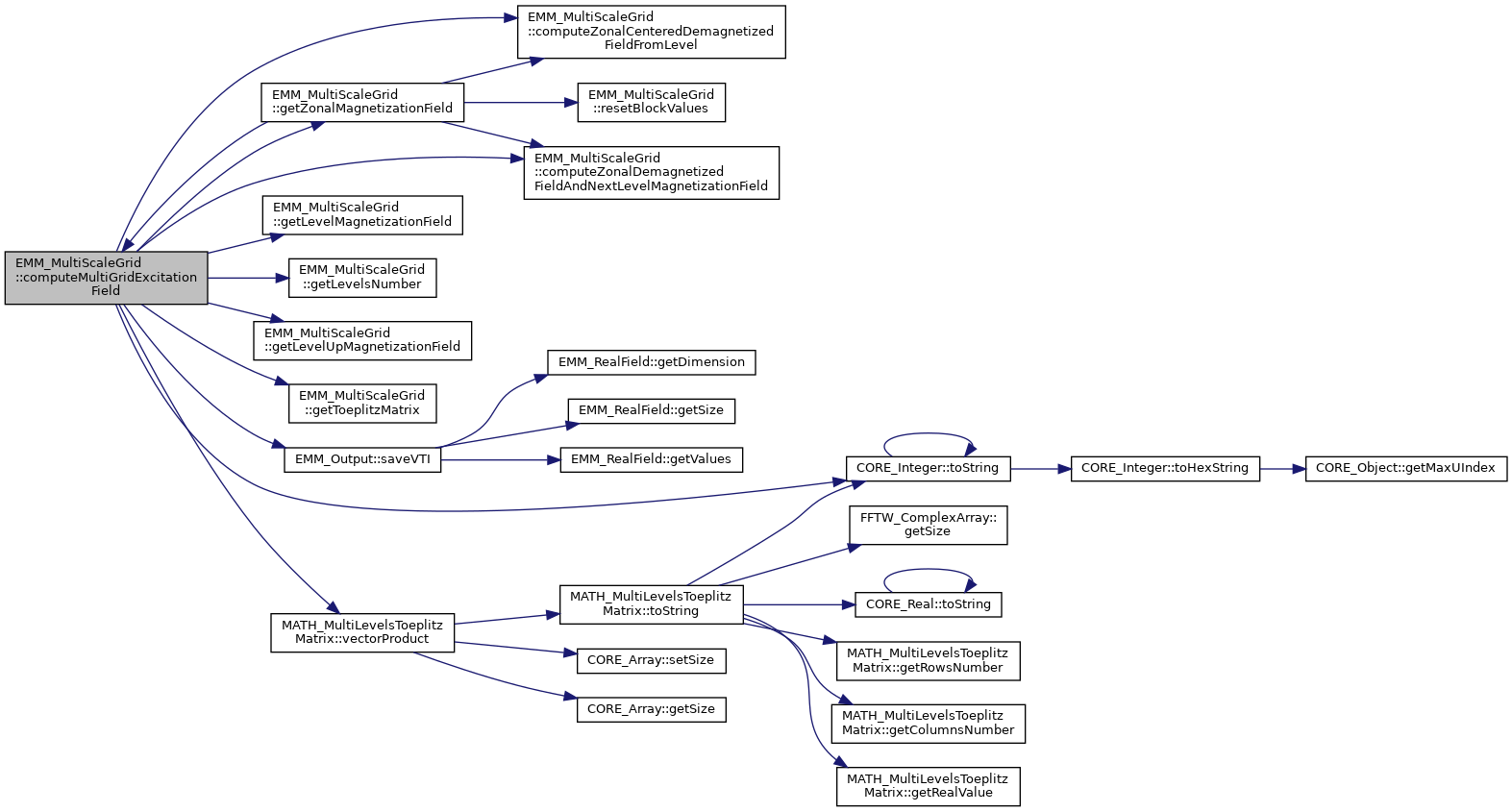

◆ computeZonalCenteredDemagnetizedFieldFromLevel()
|
inlineprotectedvirtual |
compute the centered demagnetized field of level l outside zone anad add it to demagnetized field at level 0
- Parameters
-
[in] twoPowerL : ratio size of the grid at level l [in] nCells : number of cells of the mesh [in] dim dimension of each point of the mesh [in,out] Ml magnetization values of size nCells x dim at level l [out] Mz magnetization at zone . Working field [in,out] H0 : demagnetized excitation field at level 0
- reset the magnetization M0 on cells of the coarse grid at level l which are included in its fine grid at level l-1
- computes H=Hd(M0)
- add H to H0 from the level 0
Implements EMM_MultiScaleGrid.
Reimplemented in EMM_MultiScaleSDGrid.
References computeDemagnetizedExcitationFieldFromLevel(), computeMagnetizationFieldAtNextLevel(), tDimension, tReal, tUIndex, and tUInteger.
Referenced by EMM_MultiScaleSDGrid::computeZonalCenteredDemagnetizedFieldFromLevel().
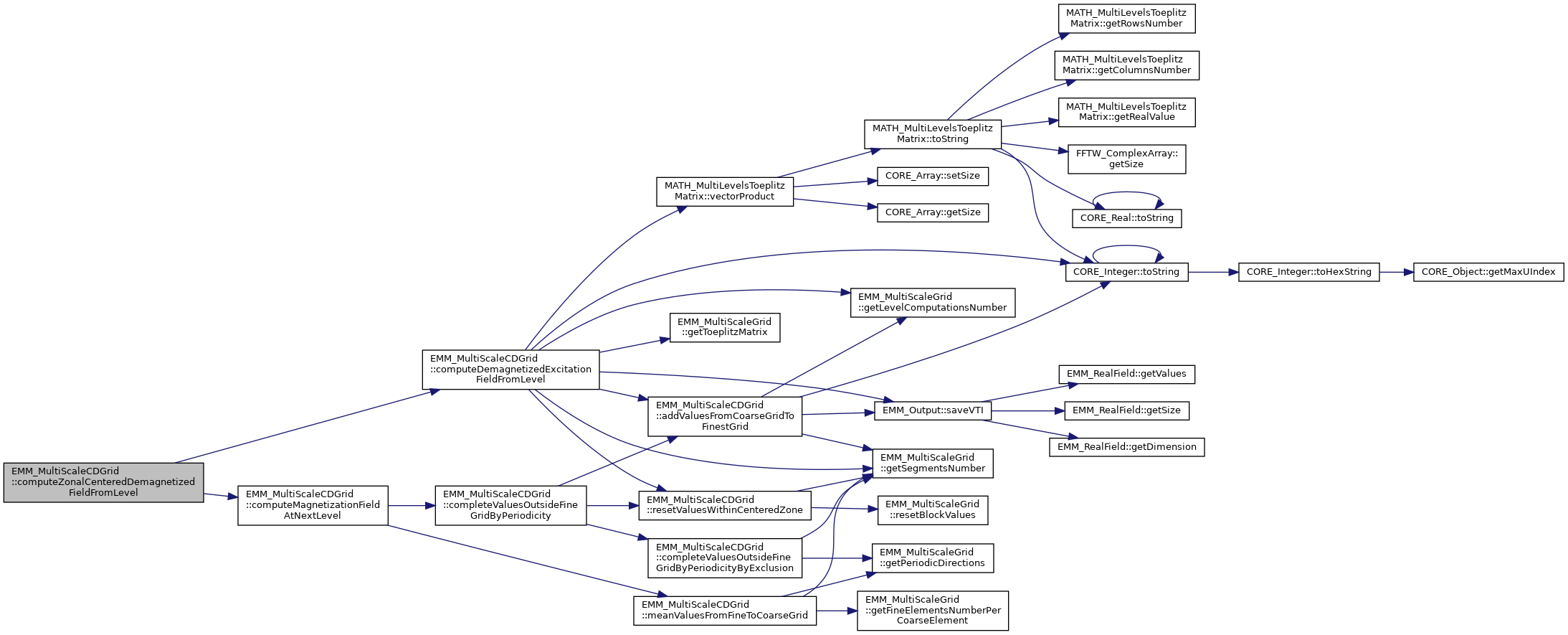

◆ computeZonalDemagnetizedFieldAndNextLevelMagnetizationField()
|
inlineprotectedvirtual |
compute the zonal demagnetized field added to demagnetized field at level 0 and compute the magnetization field at level l+1
- Parameters
-
[in] twoPowerL : ratio size of the grid at level l [in] nCells : number of cells of the mesh [in] dim dimension of each point of the mesh [in] Ml magnetization at level l [out] Mz magnetization at zone . Working field [in,out] Mlp1 magnetization values of size nCells x dim at level l+1 [in,out] H0 : demagnetized excitation field at level 0
It computes the magnetization field at level l+1. No zone.
Implements EMM_MultiScaleGrid.
Reimplemented in EMM_MultiScaleSDGrid.
References computeMagnetizationFieldAtNextLevel().
Referenced by EMM_MultiScaleSDGrid::computeZonalDemagnetizedFieldAndNextLevelMagnetizationField().


◆ getClassName() [1/2]
|
inherited |
return the class name of the object
- Returns
- the class name of the object
References tString.
Referenced by CORE_Object::getIdentityString(), EMM_Operator::getName(), and CORE_Object::isMemoryChecked().

◆ getClassName() [2/2]
return the class name of the object
- Parameters
-
identityString the identity string of the object
- Returns
- the class name
◆ getDoubleEpsilon()
|
inlinestaticinherited |
get the epsilon value for tDouble type
- Returns
- the epsilon value for tDouble type
Referenced by CORE_Test::testType().
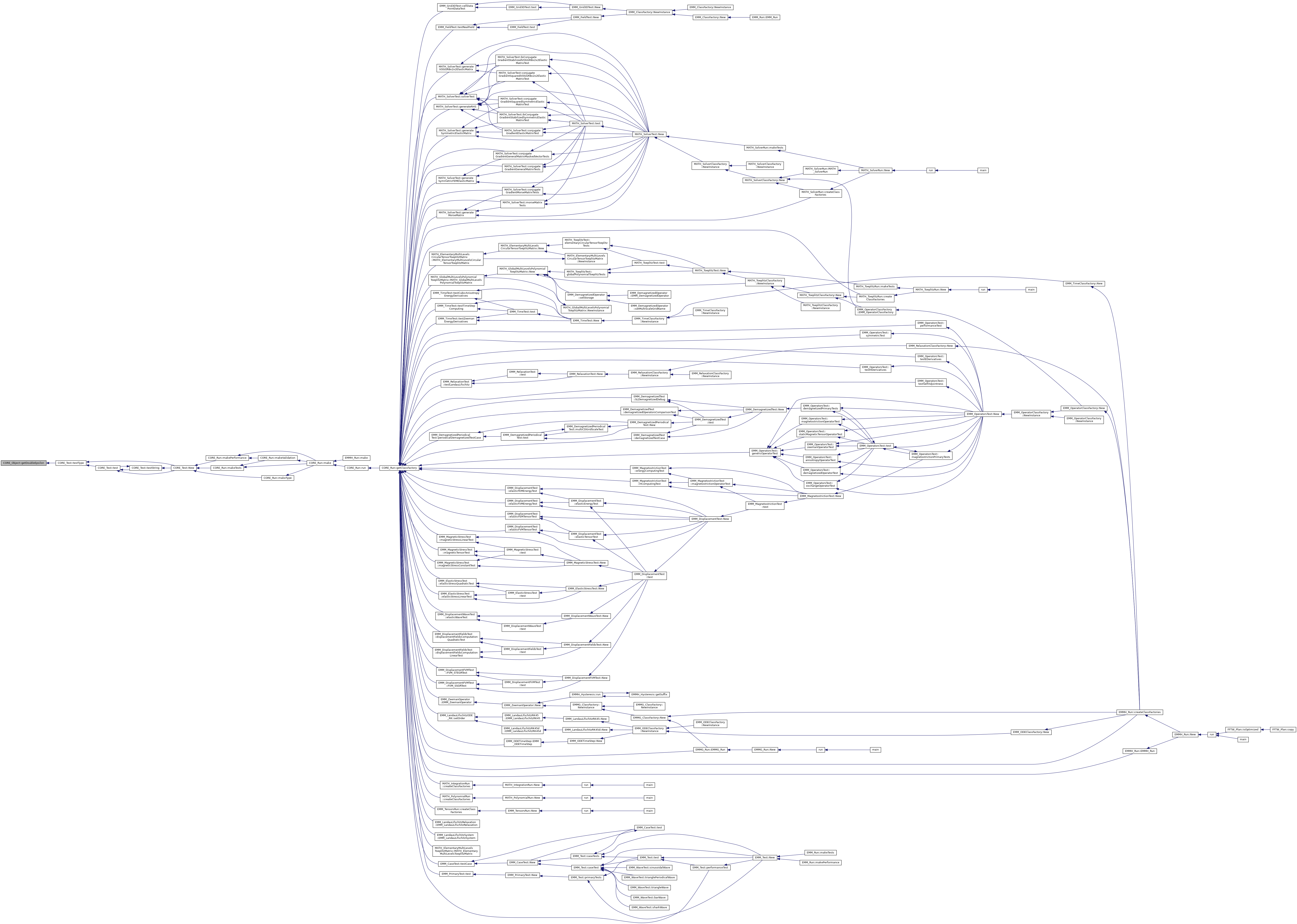
◆ getDoubleInfinity()
|
inlinestaticinherited |
get the infinity value for tFloat type
- Returns
- the intinity value for tFloat type
◆ getEpsilon()
|
inlinestaticinherited |
get the epsilon value for T type
- Returns
- the epsilon value for T type
◆ getFineElementsNumberPerCoarseElement()
|
inlineinherited |
get the number of elements of the fine grid per cell of the corse grid
- Returns
- the number of elements of the fine grid per cell of the corse grid
References EMM_MultiScaleGrid::mFineElementsNumberPerCoarseElement.
Referenced by meanValuesFromFineToCoarseGrid(), and EMM_MultiScaleSDGrid::meanValuesFromShiftFineGridToCoarseGrid().

◆ getFloatEpsilon()
|
inlinestaticinherited |
get the epsilon value for tFloat type
- Returns
- the epsilon value for tFloat type
Referenced by CORE_Test::testType().
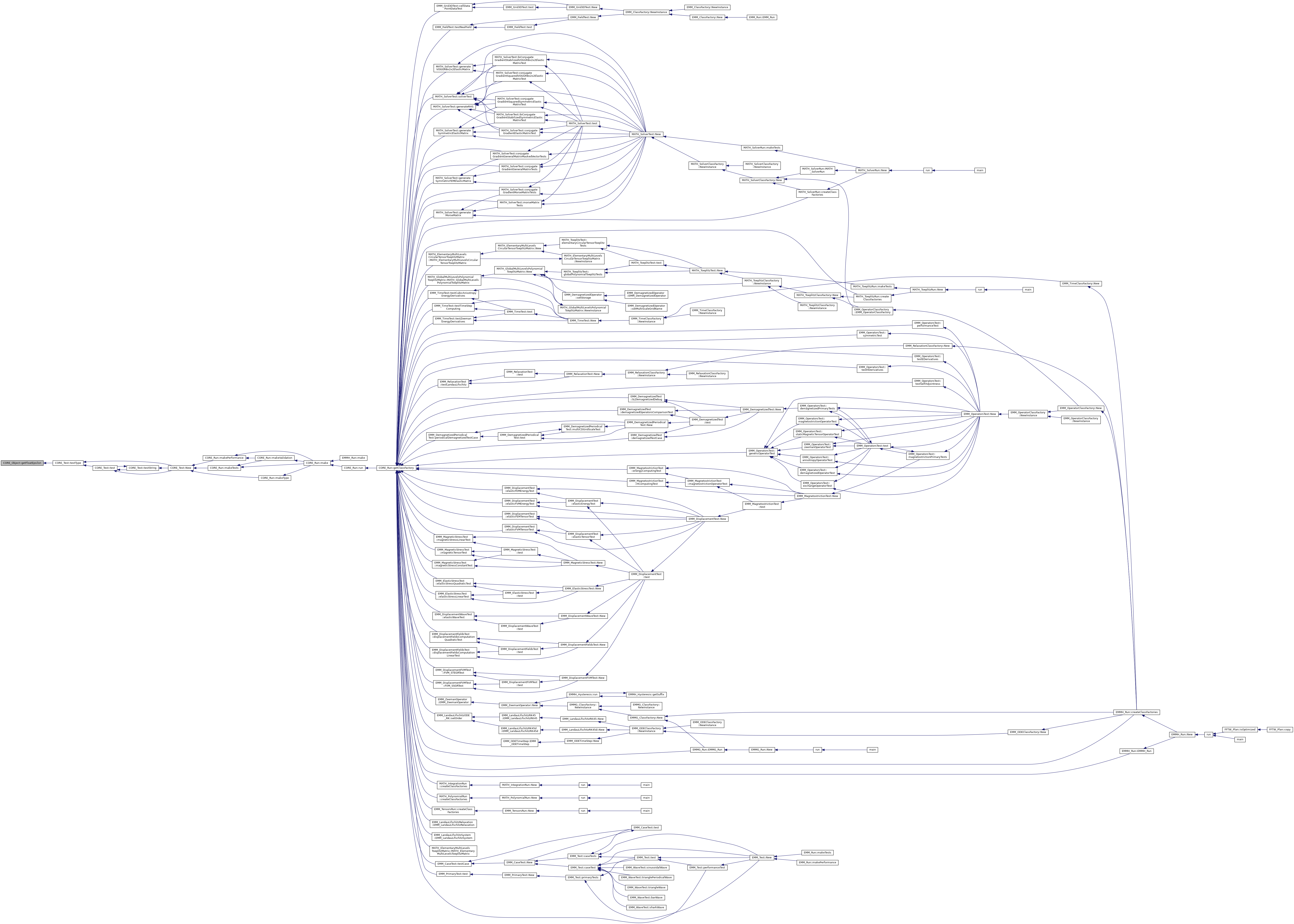
◆ getFloatInfinity()
|
inlinestaticinherited |
get the infinity value for tFloat type
- Returns
- the intinity value for tFloat type
◆ getIdentityString()
|
inlineinherited |
return the identity string of the object of the form className_at_address
- Returns
- the identity string of the object
References CORE_Object::getClassName(), CORE_Object::pointer2String(), and tString.
Referenced by MATH_GaussLegendreIntegration::copy(), EMM_MultiScaleGrid::initialize(), CORE_Object::isInstanceOf(), CORE_Object::printObjectsInMemory(), MATH_Matrix::toString(), EMMG_SLPeriodicMultiScale::toString(), EMM_Stepper::toString(), EMM_AnisotropyDirectionsField::toString(), EMM_BlockMassMatrix::toString(), CORE_Object::toString(), EMM_Tensors::toString(), EMM_MultiScaleGrid::toString(), EMM_MatterField::toString(), EMM_Grid3D::toString(), and EMM_LandauLifschitzSystem::toString().

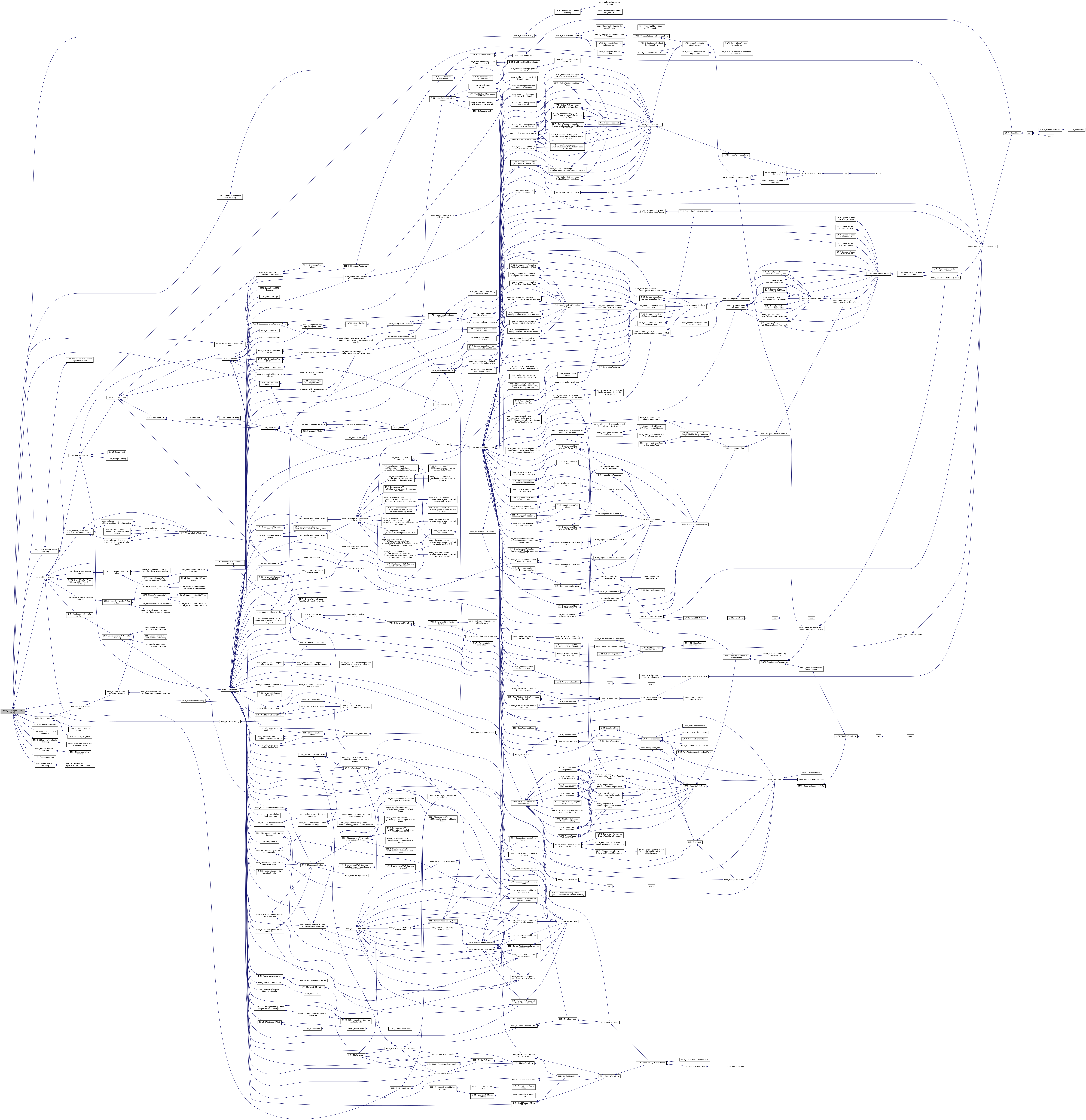
◆ getInfinity()
|
inlinestaticinherited |
get the infinity for T type
- Returns
- the infinity value for T type
◆ getLDoubleEpsilon()
|
inlinestaticinherited |
get the epsilon value for tLDouble type
- Returns
- the epsilon value for tLDouble type
Referenced by CORE_Test::testType().

◆ getLDoubleInfinity()
|
inlinestaticinherited |
get the infinity value for tDouble type
- Returns
- the infinity value for tDouble type
◆ getLevelComputationsNumber() [1/2]
|
inlineprotectedinherited |
return the number of calls of the level computations only for debug
- Returns
- the number of calls of the level computations only for debug
References EMM_MultiScaleGrid::mLevelComputationsNumber.
Referenced by addValuesFromCoarseGridToFinestGrid(), EMM_MultiScaleSDGrid::addValuesFromGridToZoneFinestGrid(), computeDemagnetizedExcitationFieldFromLevel(), EMM_MultiScaleSDGrid::computeZonalCenteredDemagnetizedFieldFromLevel(), and EMM_MultiScaleSDGrid::computeZonalDemagnetizedFieldAndNextLevelMagnetizationField().

◆ getLevelComputationsNumber() [2/2]
|
inlineprotectedinherited |
return the number of calls of the level computations only for debug
- Returns
- the number of calls of the level computations only for debug
References EMM_MultiScaleGrid::mLevelComputationsNumber, EMM_MultiScaleGrid::toString(), and tString.

◆ getLevelMagnetizationField()
|
inlineinherited |
get the magnetization field at level l
- Returns
- the magnetiaztion field at level l
Referenced by EMM_MultiScaleGrid::computeMultiGridExcitationField().

◆ getLevelsNumber()
|
inlineinherited |
get the leves number
- Returns
- the levels number
References EMM_MultiScaleGrid::mLevelsNumber.
Referenced by EMMG_SLRPPeriodicMultiScale::computeMultiGridExcitationField(), EMMG_SLSDXPeriodicMultiScale::computeMultiGridExcitationField(), and EMM_MultiScaleGrid::computeMultiGridExcitationField().

◆ getLevelUpMagnetizationField()
|
inlineinherited |
get the magnetization field at level l+1
- Returns
- the magnetiaztion field at level l+1
Referenced by EMM_MultiScaleGrid::computeMultiGridExcitationField().

◆ getMaxChar()
|
inlinestaticinherited |
get the max value for tChar type
- Returns
- the max value for tChar type
Referenced by CORE_Test::testType().

◆ getMaxDouble()
|
inlinestaticinherited |
get the max value for tDouble type
- Returns
- the max value for tDouble type
Referenced by CORE_Test::testType().
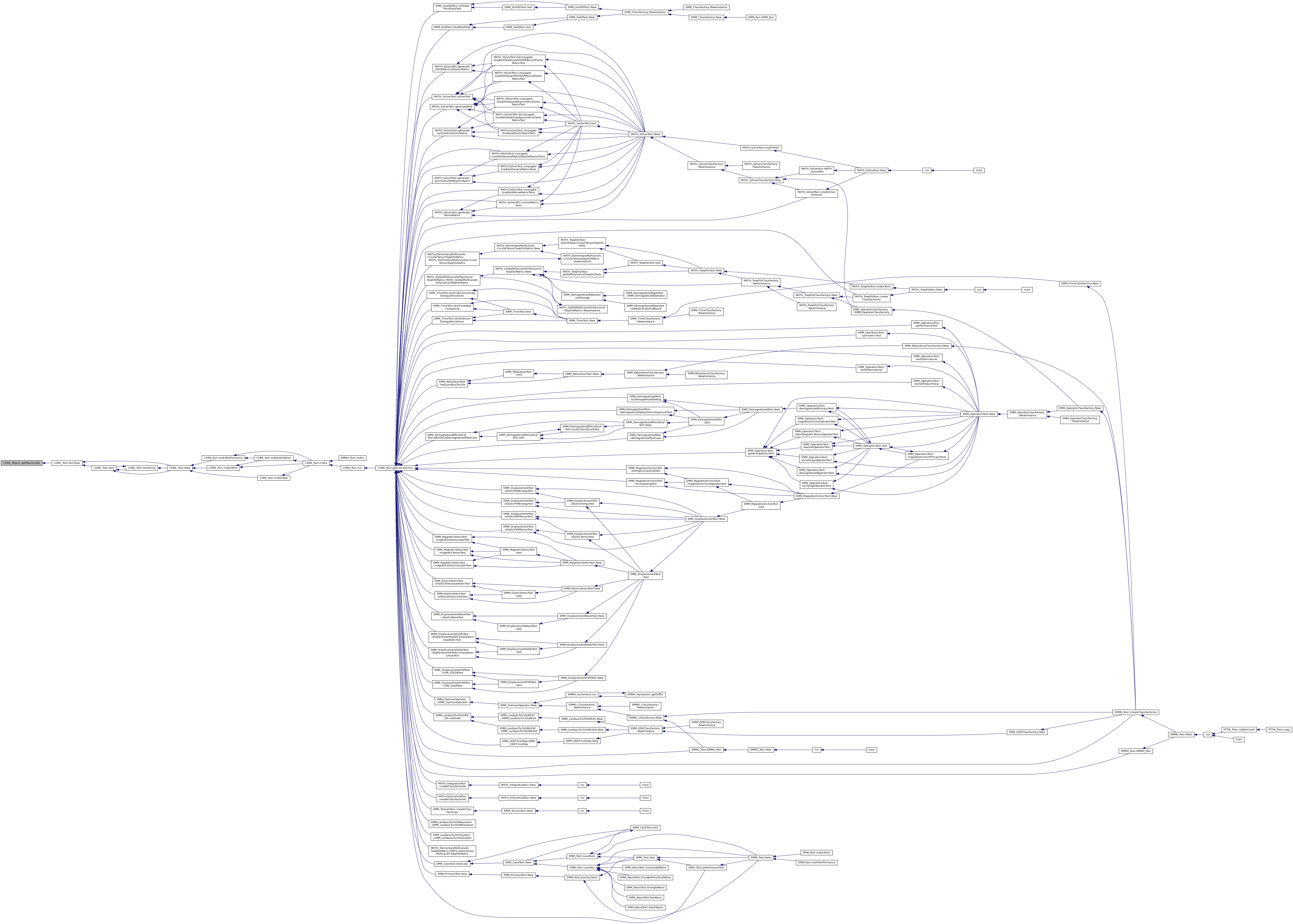
◆ getMaxFlag()
|
inlinestaticinherited |
get the max value for the tFlag type
- Returns
- the max value for the tFlag type
Referenced by CORE_Test::testType().

◆ getMaxFloat()
|
inlinestaticinherited |
get the max value for tFloat type
- Returns
- the max value for tFloat type
Referenced by CORE_Test::testType().
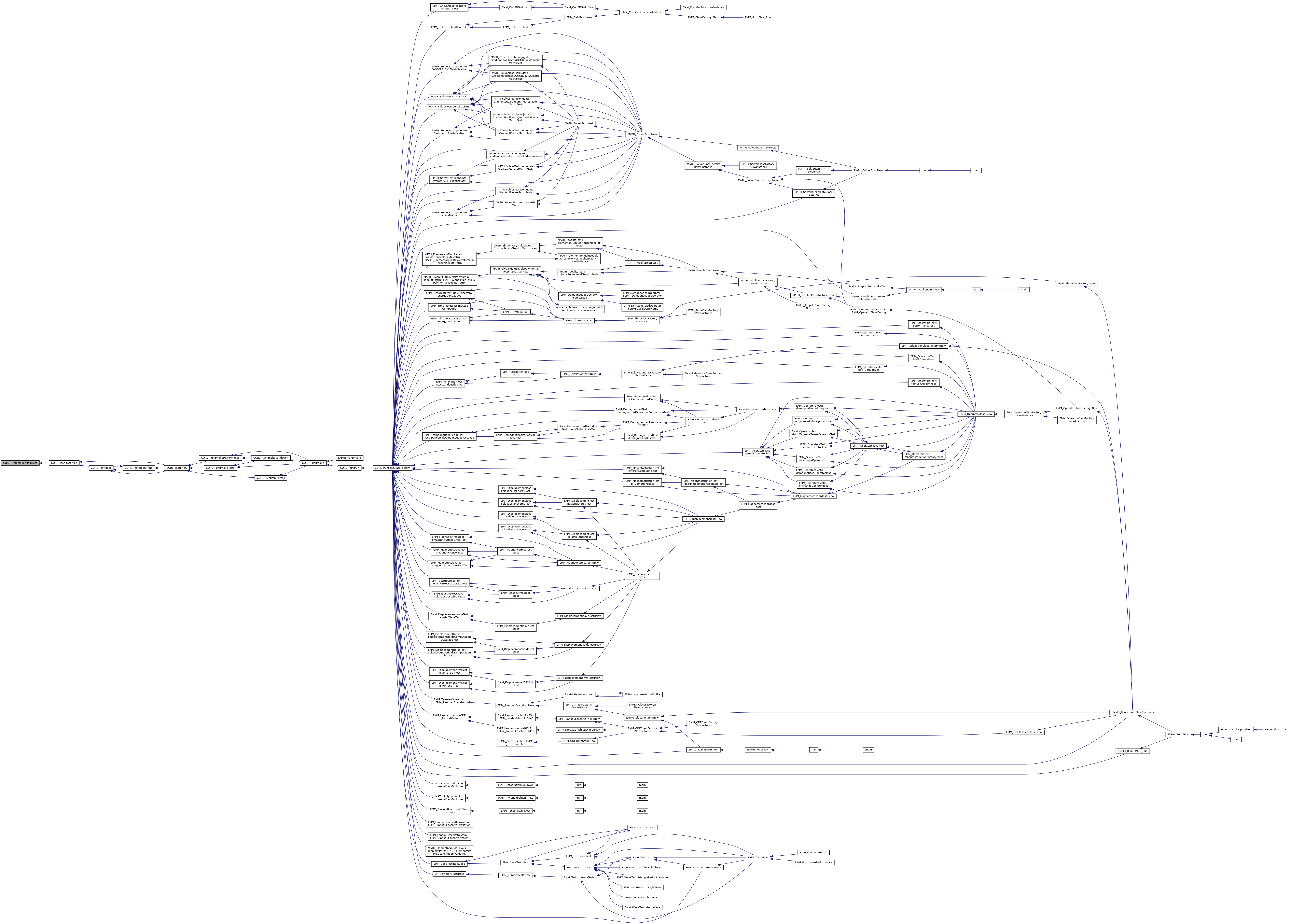
◆ getMaxIndex()
|
inlinestaticinherited |
get the max value for the array/vector indexing type
- Returns
- the max value for the array/vector indexing type
Referenced by CORE_Test::testType().
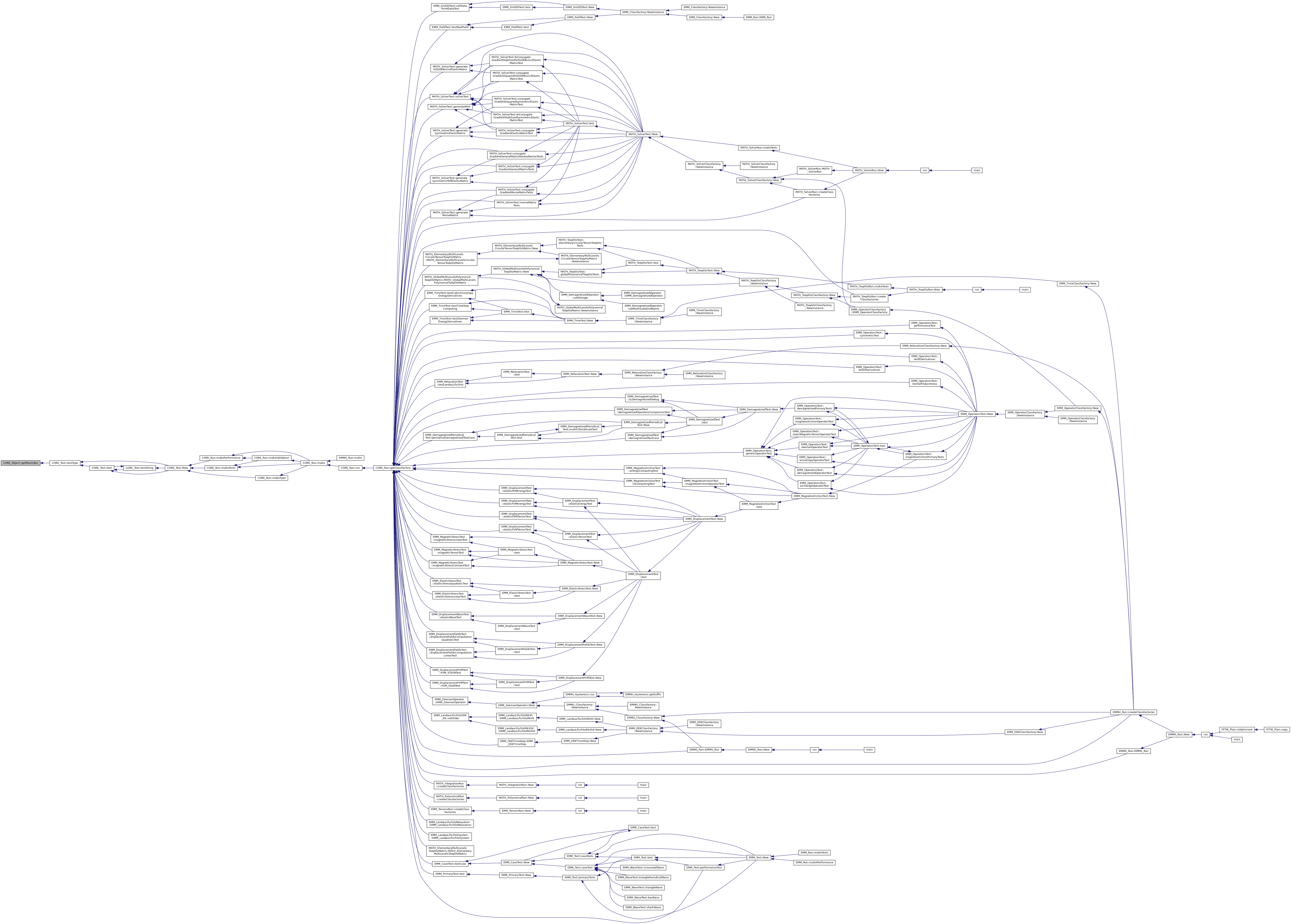
◆ getMaxInt()
|
inlinestaticinherited |
get the max value for tInt type
- Returns
- the max value for tInt type
Referenced by MATSGN_FFT::fastFourierTransform3D_FFTW(), and CORE_Test::testType().

◆ getMaxInteger()
|
inlinestaticinherited |
get the max value for the integer type
- Returns
- the max value for the integer type
Referenced by CORE_Test::testType().
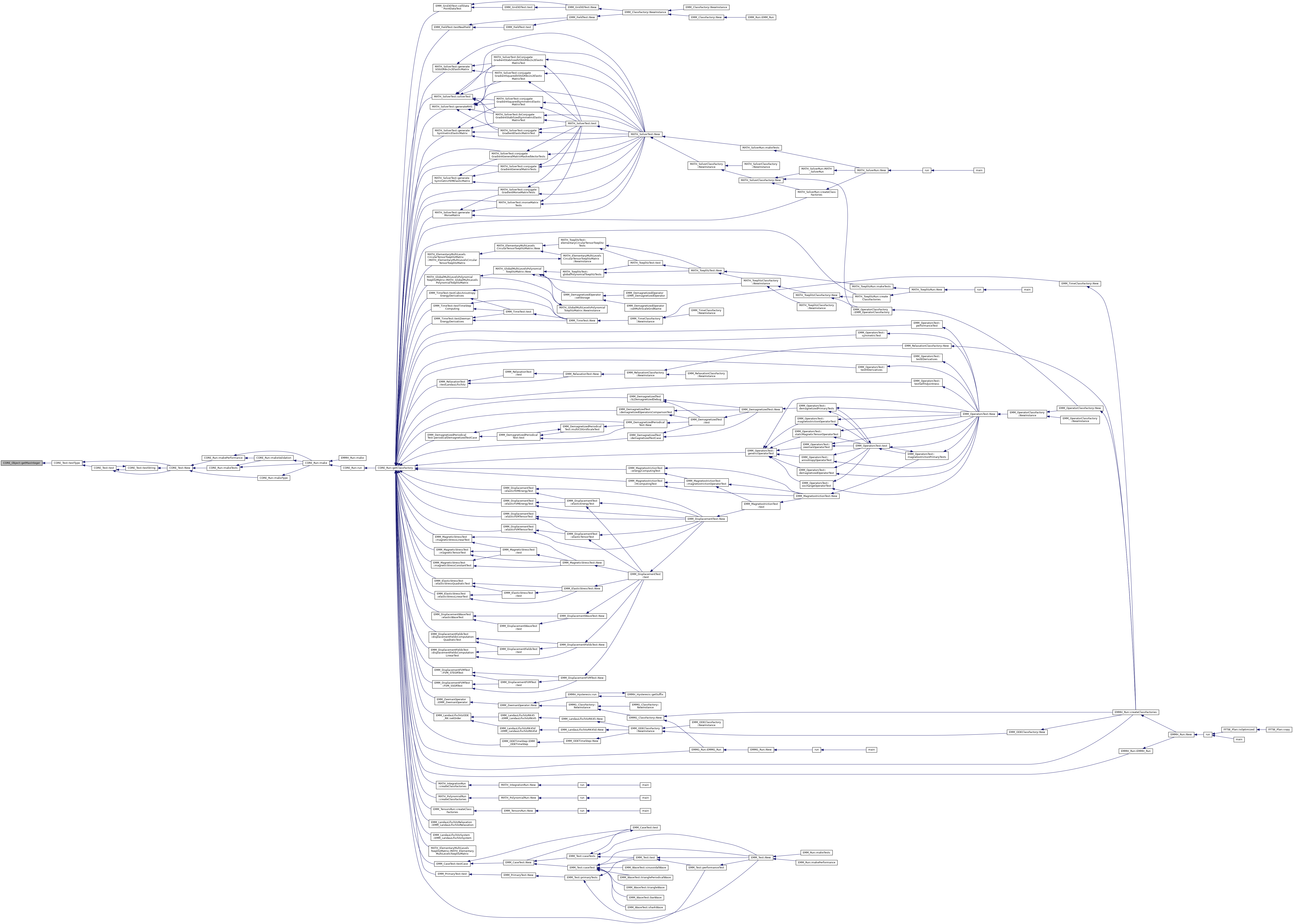
◆ getMaxLDouble()
|
inlinestaticinherited |
get the max value for tLDouble type
- Returns
- the max value for tLDouble type
Referenced by CORE_Test::testType().
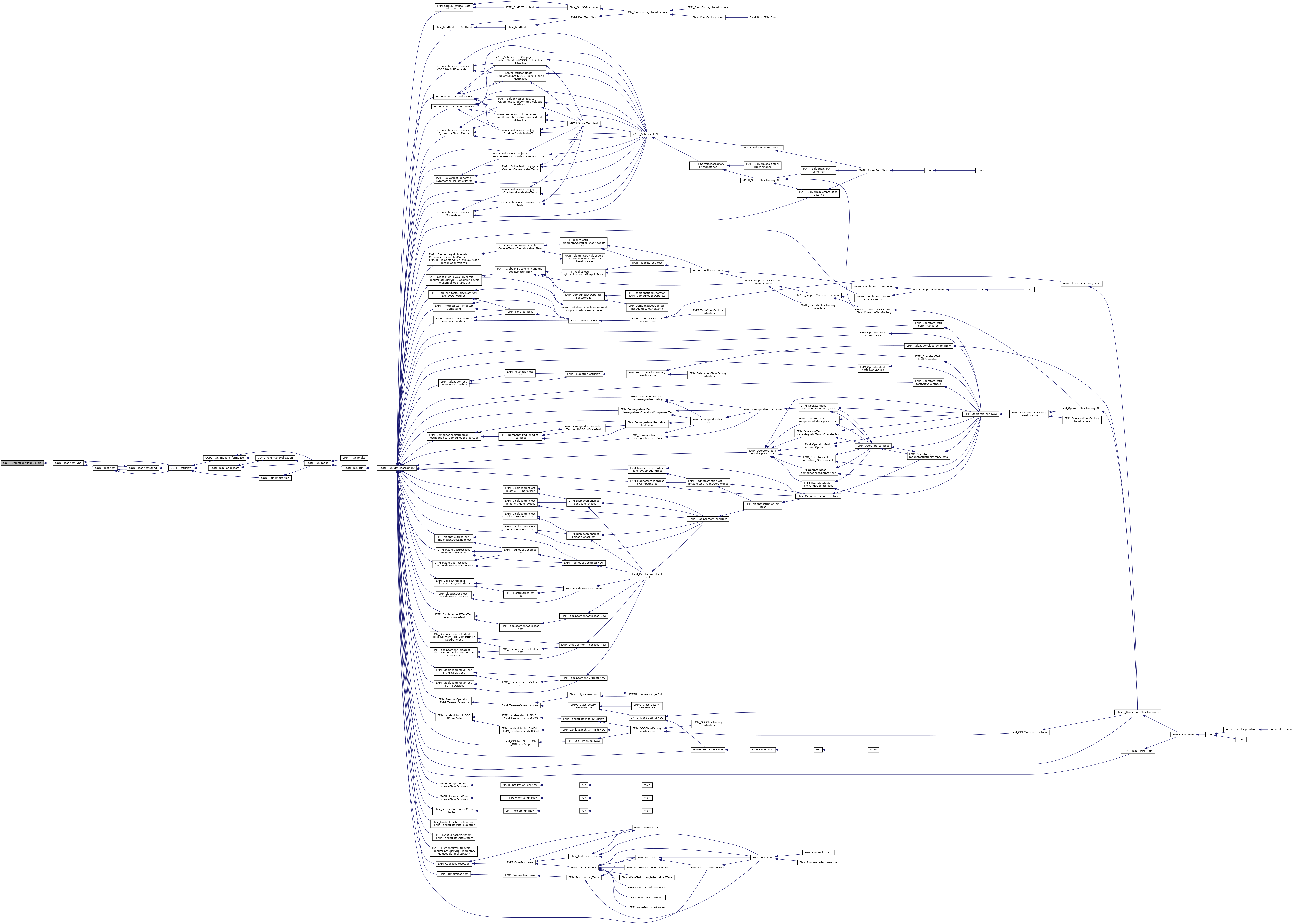
◆ getMaxLInt()
|
inlinestaticinherited |
get the max value for tLInt type
- Returns
- the max value for tLInt type
Referenced by CORE_Test::testType().

◆ getMaxLLInt()
|
inlinestaticinherited |
get the max value for tULInt type
- Returns
- the max value for tULInt type
Referenced by CORE_Test::testType().
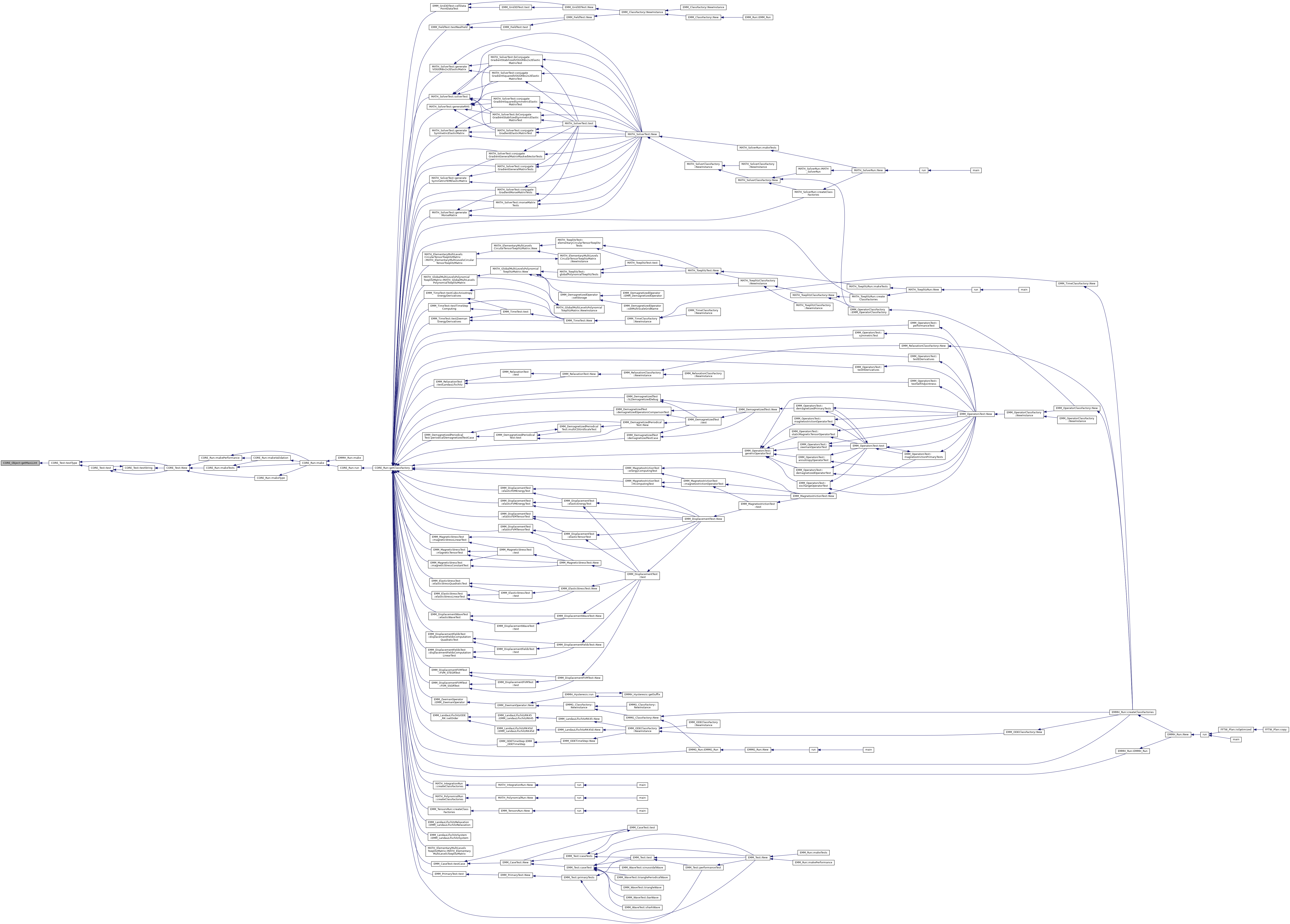
◆ getMaxReal()
|
inlinestaticinherited |
get the max value for the real type
- Returns
- he max value for the real type
Referenced by EMM_MatterField::adimensionize(), and CORE_Test::testType().

◆ getMaxSInt()
|
inlinestaticinherited |
get the max value for tSInt type
- Returns
- the max value for tSInt type
Referenced by CORE_Test::testType().
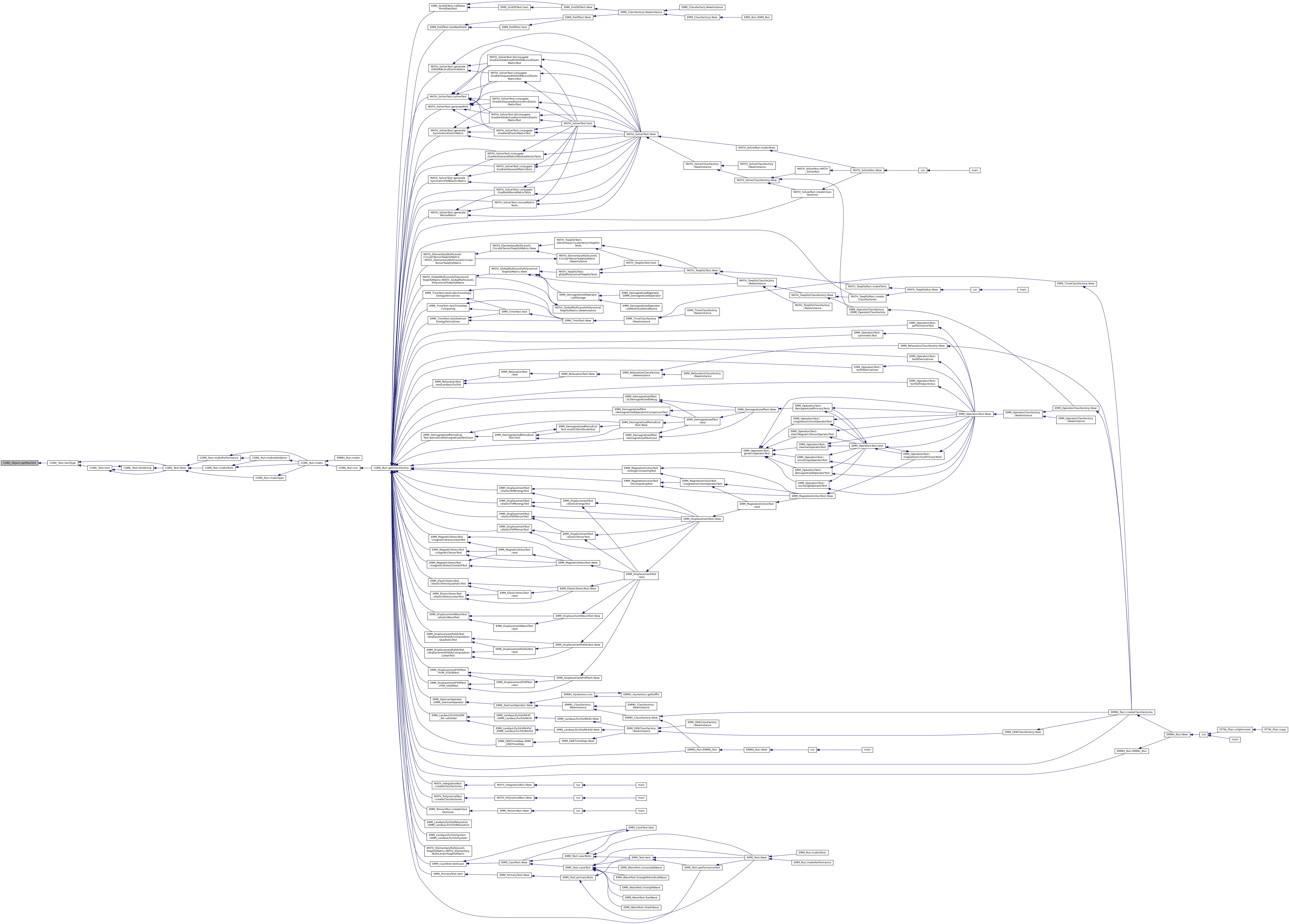
◆ getMaxUChar()
|
inlinestaticinherited |
get the max value for tUChar type
- Returns
- the max value for tUChar type
Referenced by CORE_Test::testType().
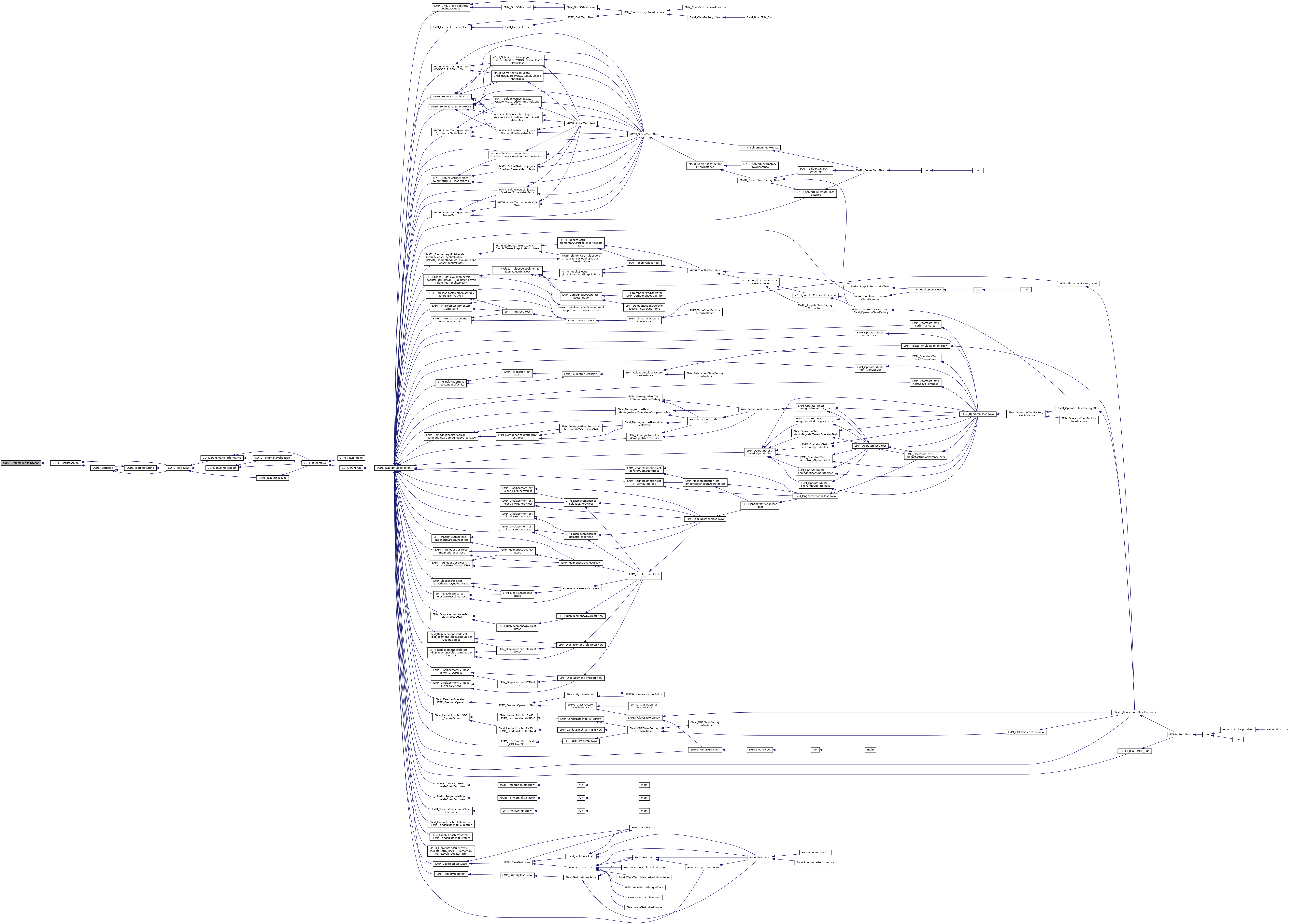
◆ getMaxUIndex()
|
inlinestaticinherited |
get the max value for difference the array/vector indexing type
- Returns
- the max value for difference the array/vector indexing type
Referenced by CORE_Vector< T >::addAfterIndices(), CORE_Vector< T >::search(), CORE_Test::testType(), CORE_Integer::toHexString(), and CORE_Integer::toString().
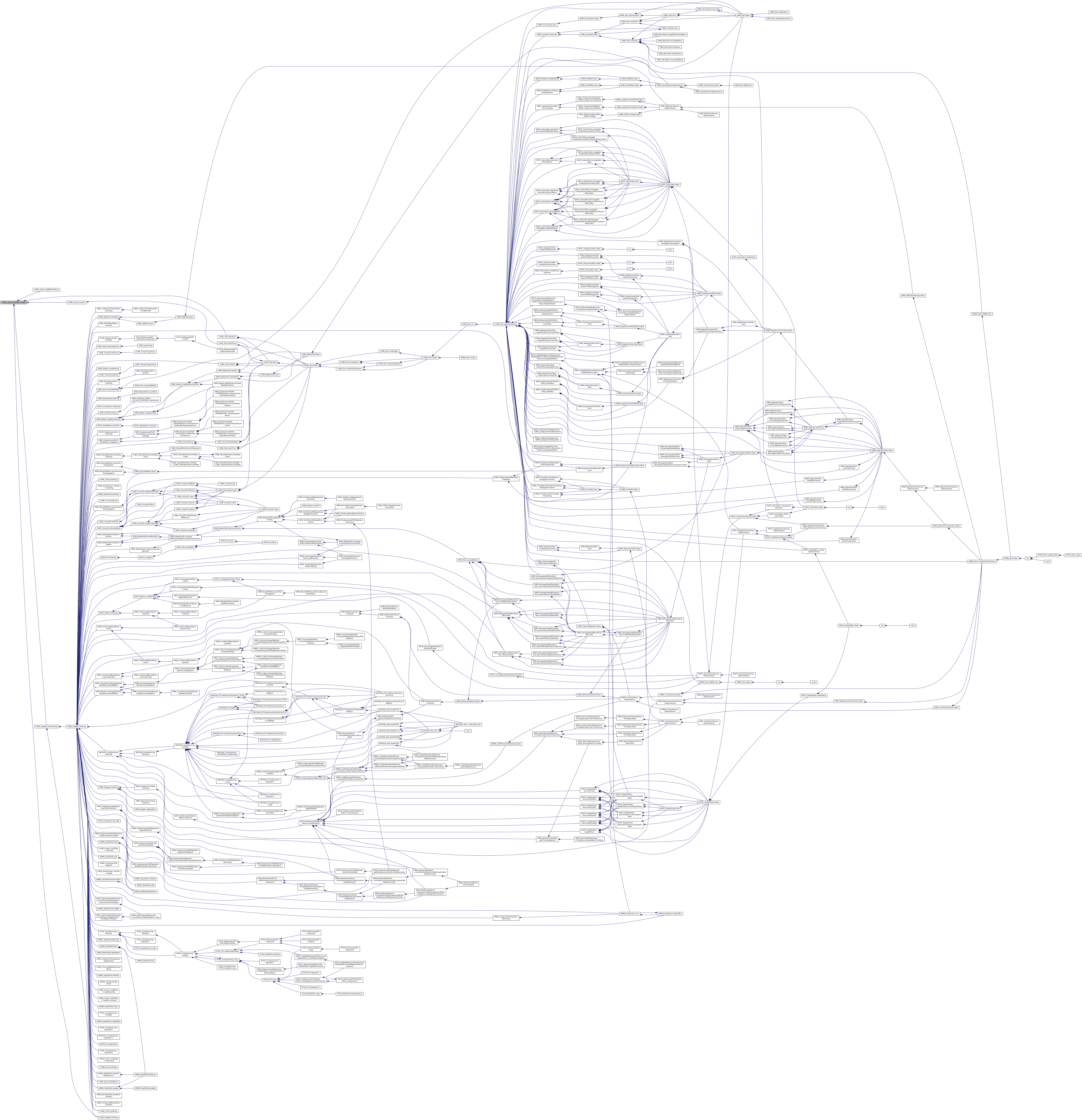
◆ getMaxUInt()
|
inlinestaticinherited |
get the max value for tUInt type
- Returns
- the max value for tUInt type
Referenced by EMM_Array< tCellFlag >::loadFromFile(), EMM_RealField::loadFromFile(), and CORE_Test::testType().

◆ getMaxUInteger()
|
inlinestaticinherited |
get the max value for the unsigned integer type
- Returns
- the max value for the unsigned integer type
Referenced by MATH_Pn::computeExtrenums(), EMM_MultiScaleGrid::computeLevelsNumber(), EMM_Input::restoreBackup(), MATH_P0::solve(), and CORE_Test::testType().

◆ getMaxULInt()
|
inlinestaticinherited |
get the max value for tULInt type
- Returns
- the max value for tULInt type
Referenced by CORE_Test::testType().
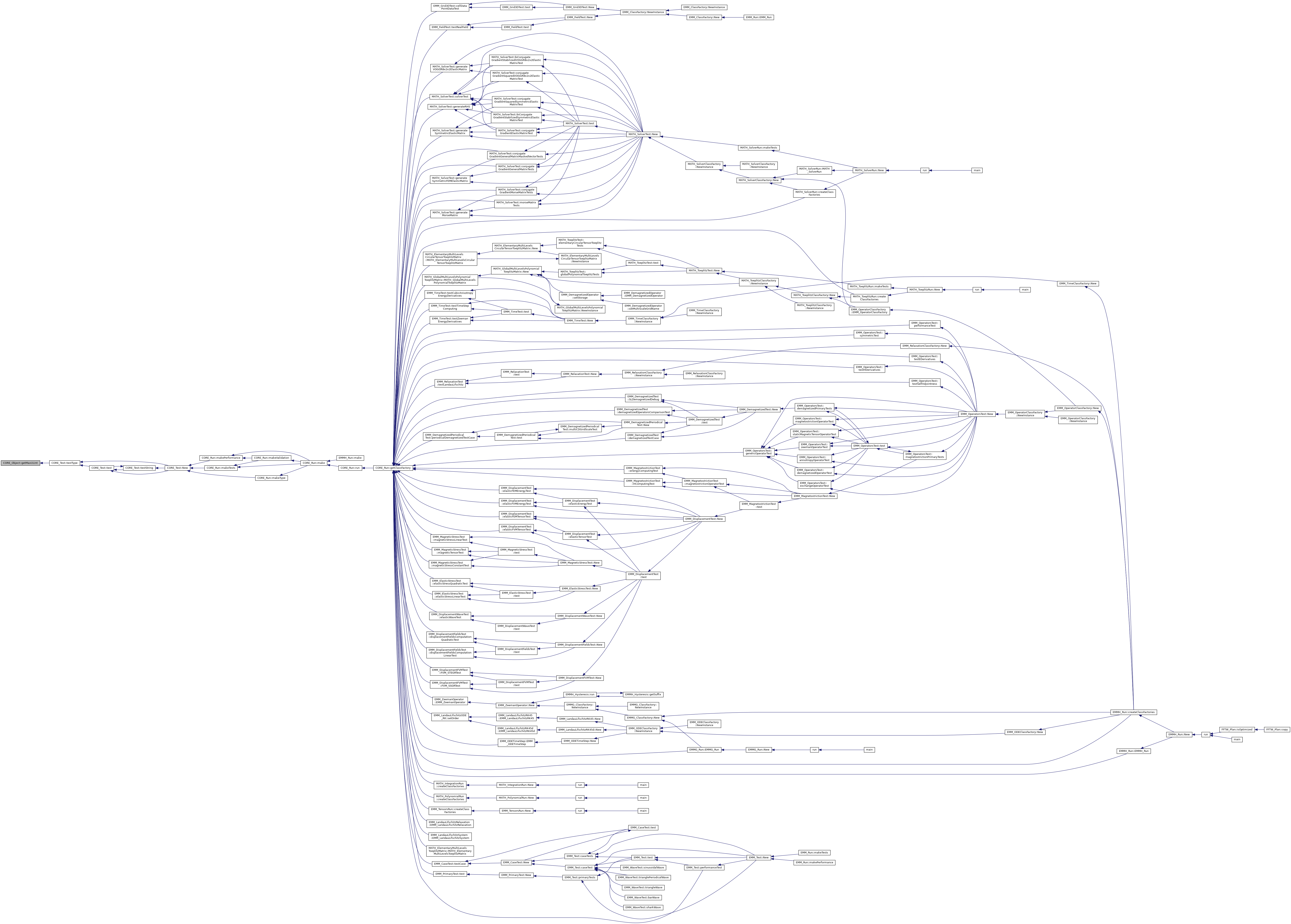
◆ getMaxULLInt()
|
inlinestaticinherited |
get the max value for tULLInt type
- Returns
- the max value for tULLInt type
Referenced by CORE_Test::testType().
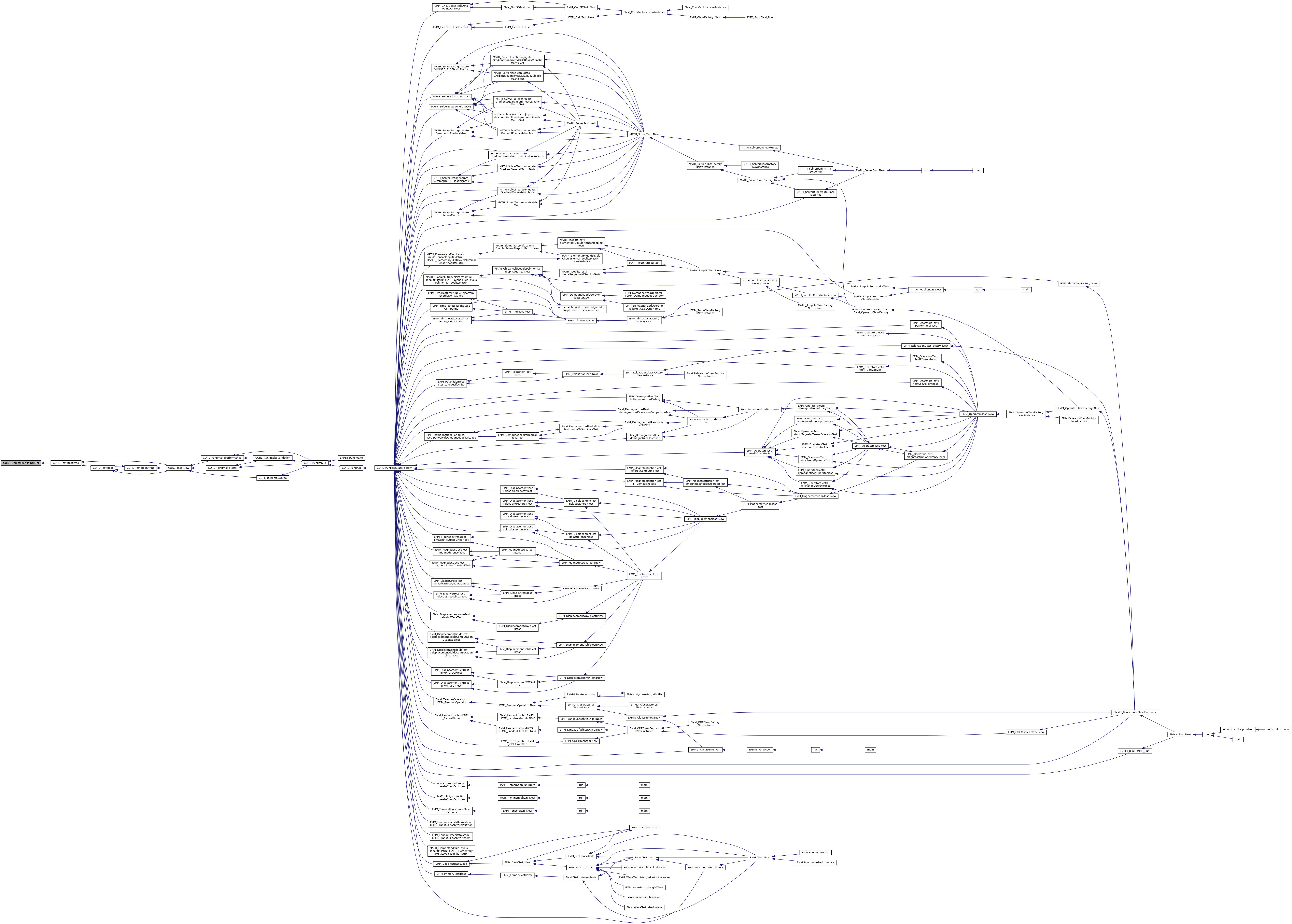
◆ getMaxUSInt()
|
inlinestaticinherited |
get the max value for tUSInt type
- Returns
- the max value for tUSInt type
Referenced by CORE_Test::testType().

◆ getMinChar()
|
inlinestaticinherited |
get the min value for tChar type
- Returns
- the min value for tChar type
Referenced by CORE_Test::testType().
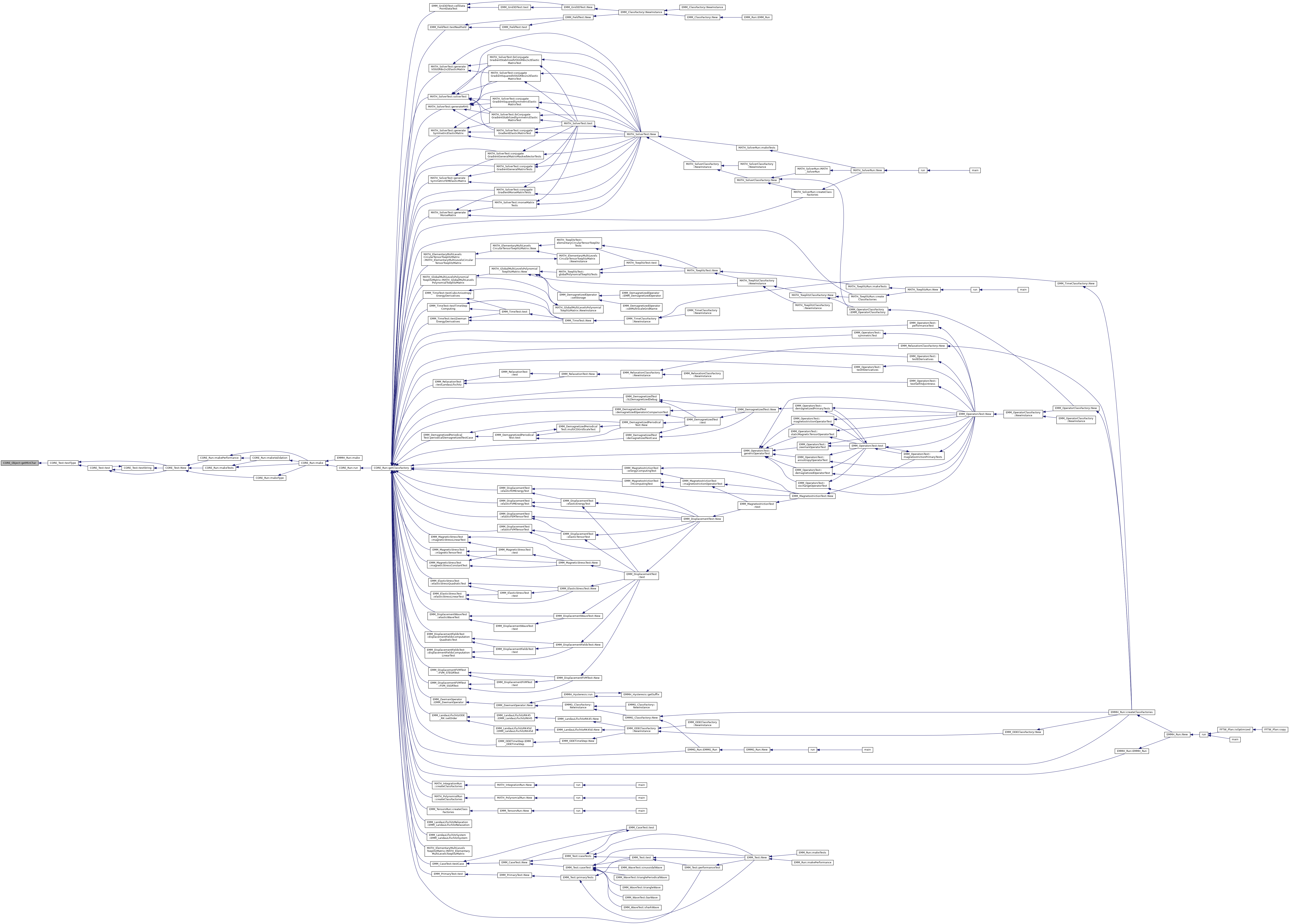
◆ getMinDouble()
|
inlinestaticinherited |
get the min value for tDouble type
- Returns
- the min value for tDouble type
Referenced by CORE_Test::testType().

◆ getMinFlag()
|
inlinestaticinherited |
get the min value for the tFlag type
- Returns
- the min value for the tFlag type
Referenced by CORE_Test::testType().
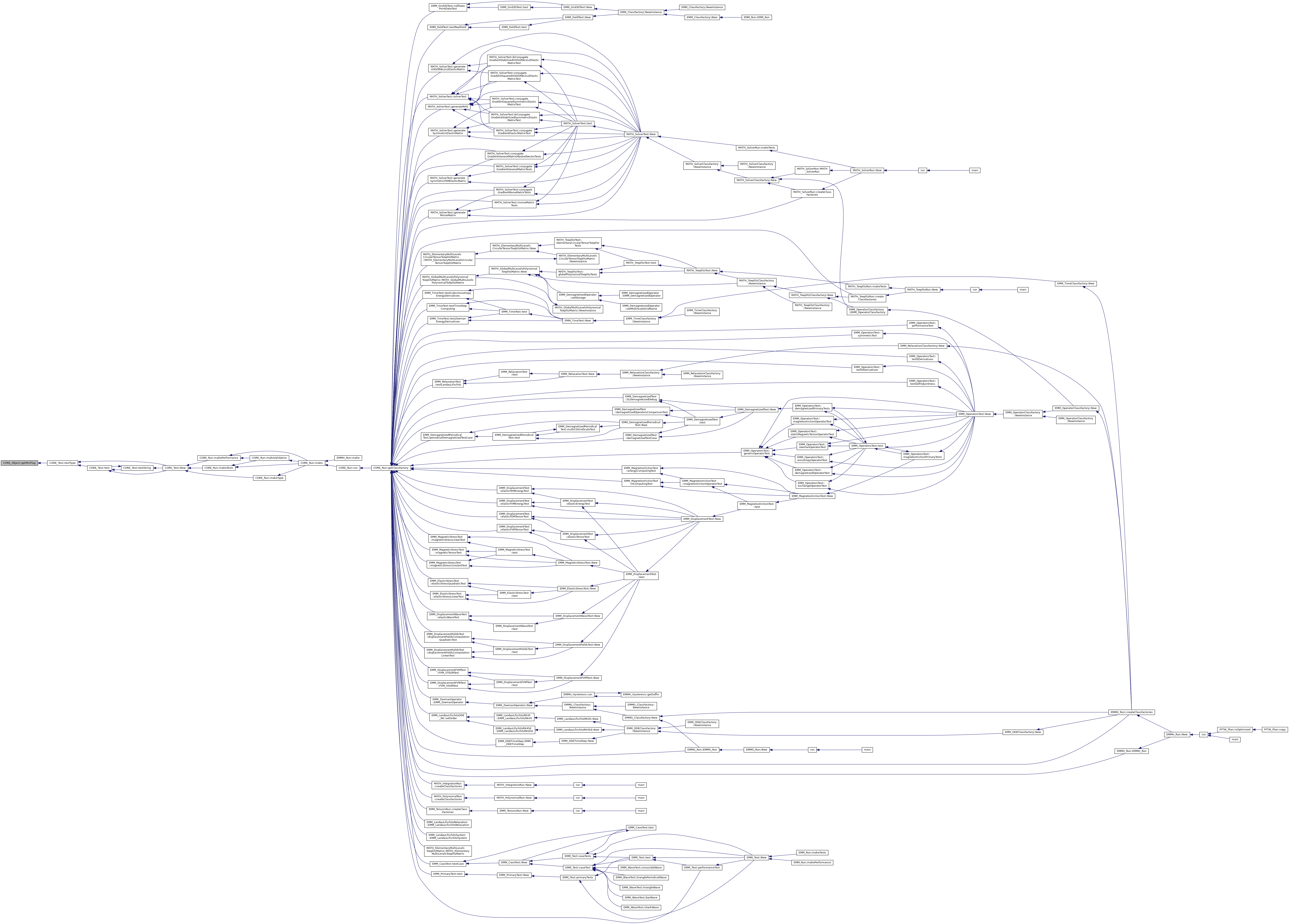
◆ getMinFloat()
|
inlinestaticinherited |
get the min value for tFloat type
- Returns
- the min value for tFloat type
Referenced by CORE_Test::testType().
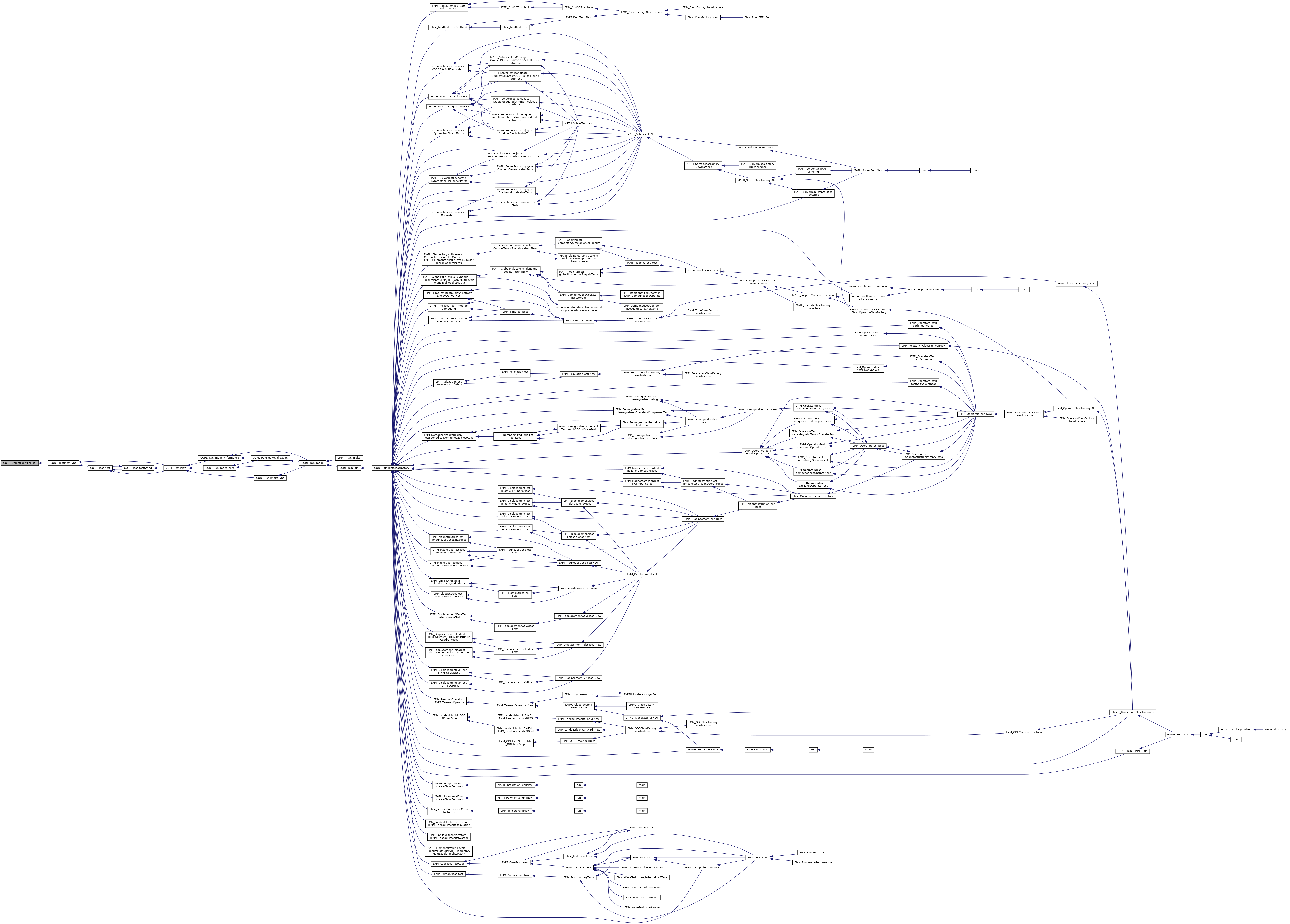
◆ getMinIndex()
|
inlinestaticinherited |
get the min value for the array/vector indexing type
- Returns
- the min value for the array/vector indexing type
Referenced by CORE_Test::testType().
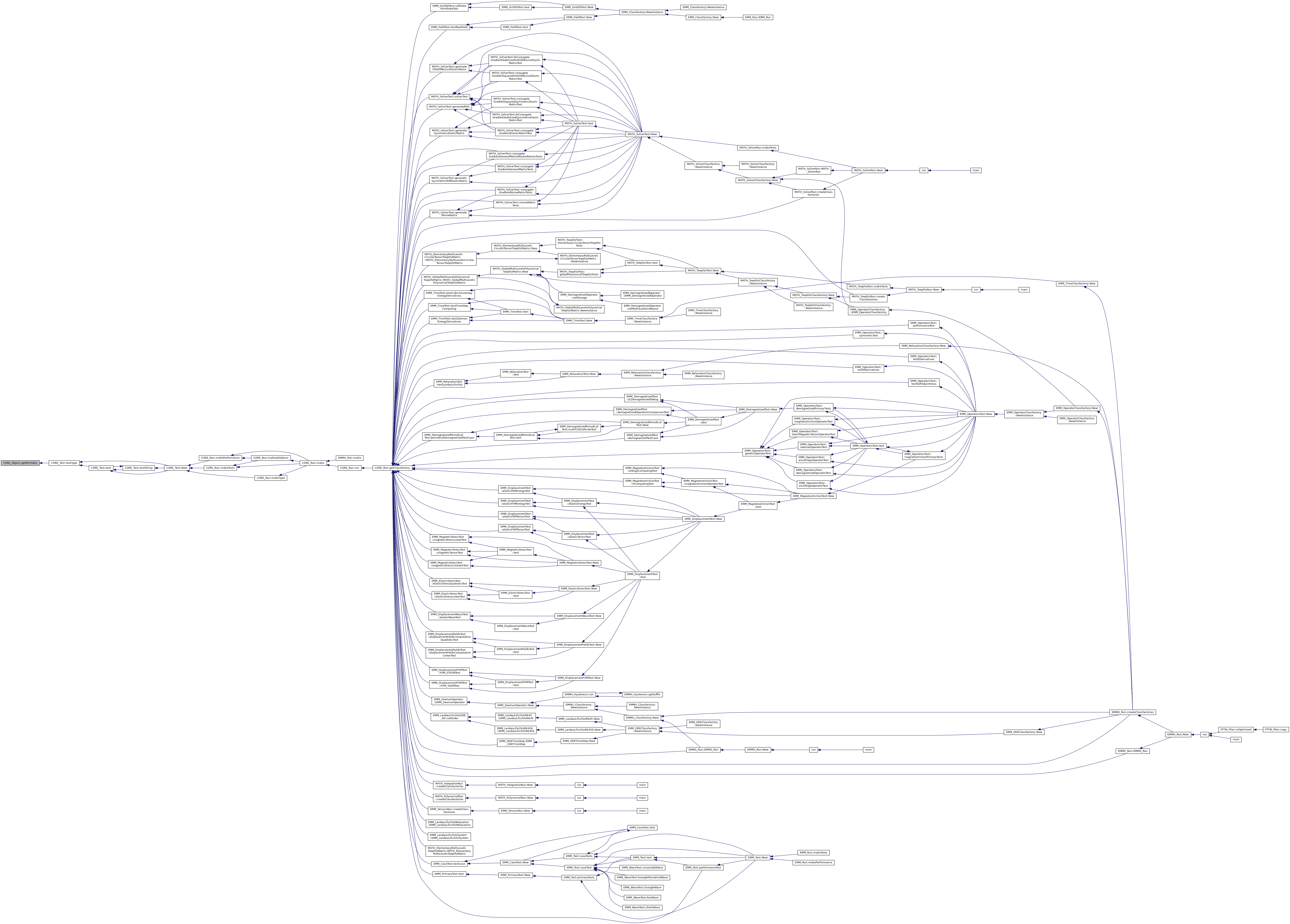
◆ getMinInt()
|
inlinestaticinherited |
get the min value for tInt type
- Returns
- the min value for tInt type
Referenced by CORE_Test::testType().
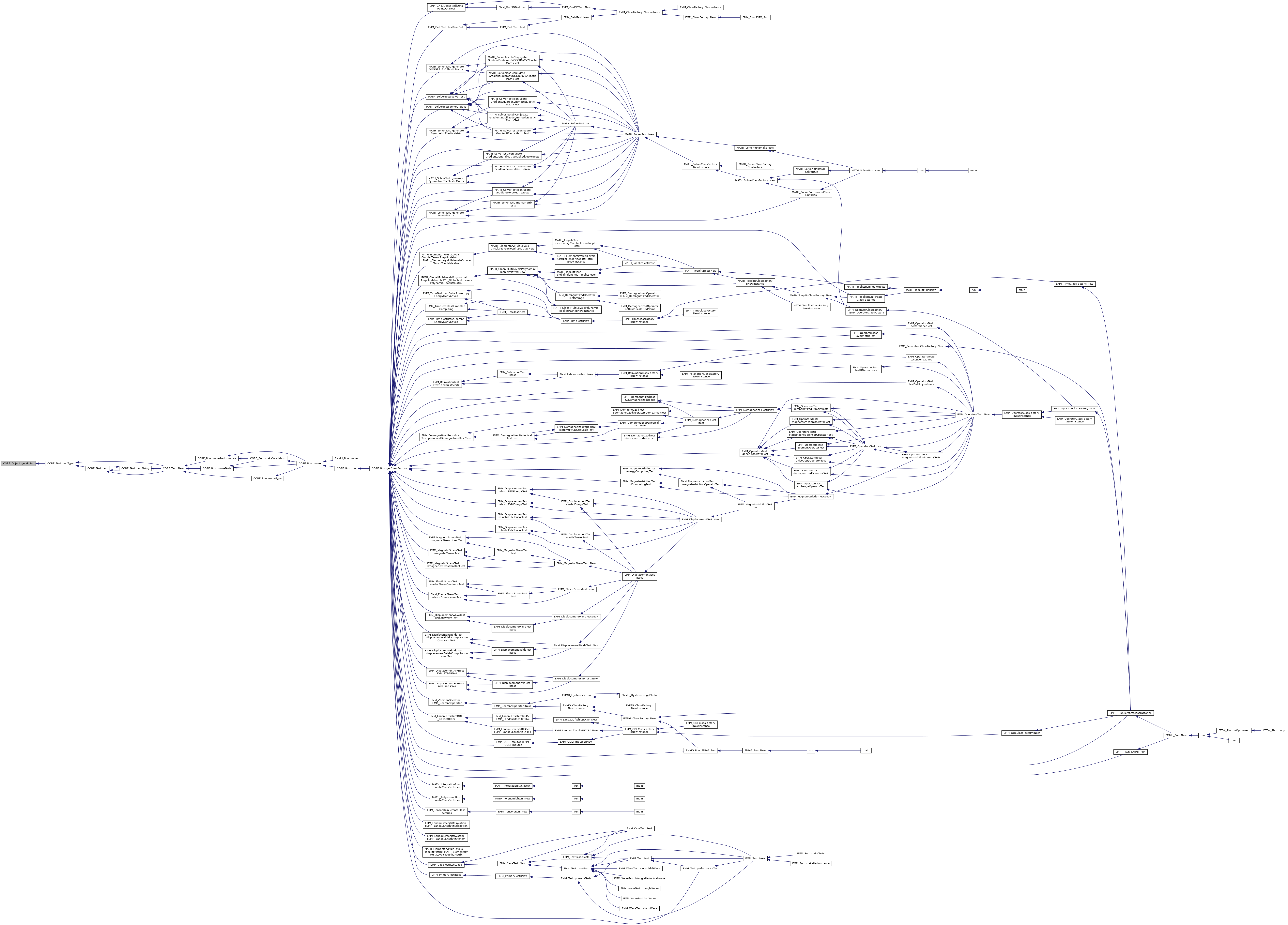
◆ getMinInteger()
|
inlinestaticinherited |
get the min value for the integer type
- Returns
- the minin value for the integer type
Referenced by CORE_Test::testType().

◆ getMinLDouble()
|
inlinestaticinherited |
get the min value for tLDouble type
- Returns
- the min value for tLDouble type
Referenced by CORE_Test::testType().

◆ getMinLInt()
|
inlinestaticinherited |
get the min value for tLInt type
- Returns
- the min value for tLInt type
Referenced by CORE_Test::testType().
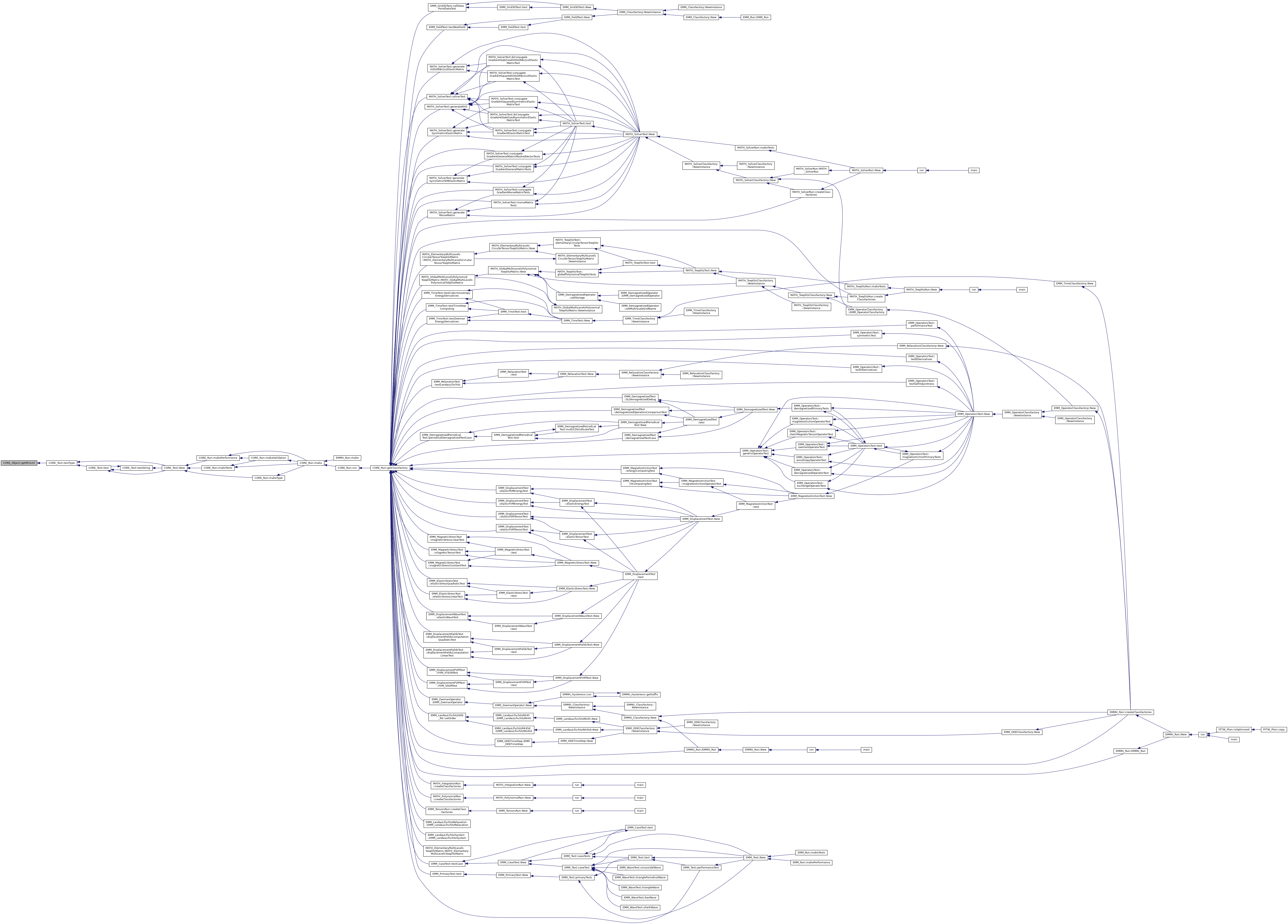
◆ getMinLLInt()
|
inlinestaticinherited |
get the min value for tLLInt type
- Returns
- the min value for tLLInt type
Referenced by CORE_Test::testType().

◆ getMinReal()
|
inlinestaticinherited |
get the min value for the real type
- Returns
- the min value for the real type
Referenced by CORE_Test::testType().
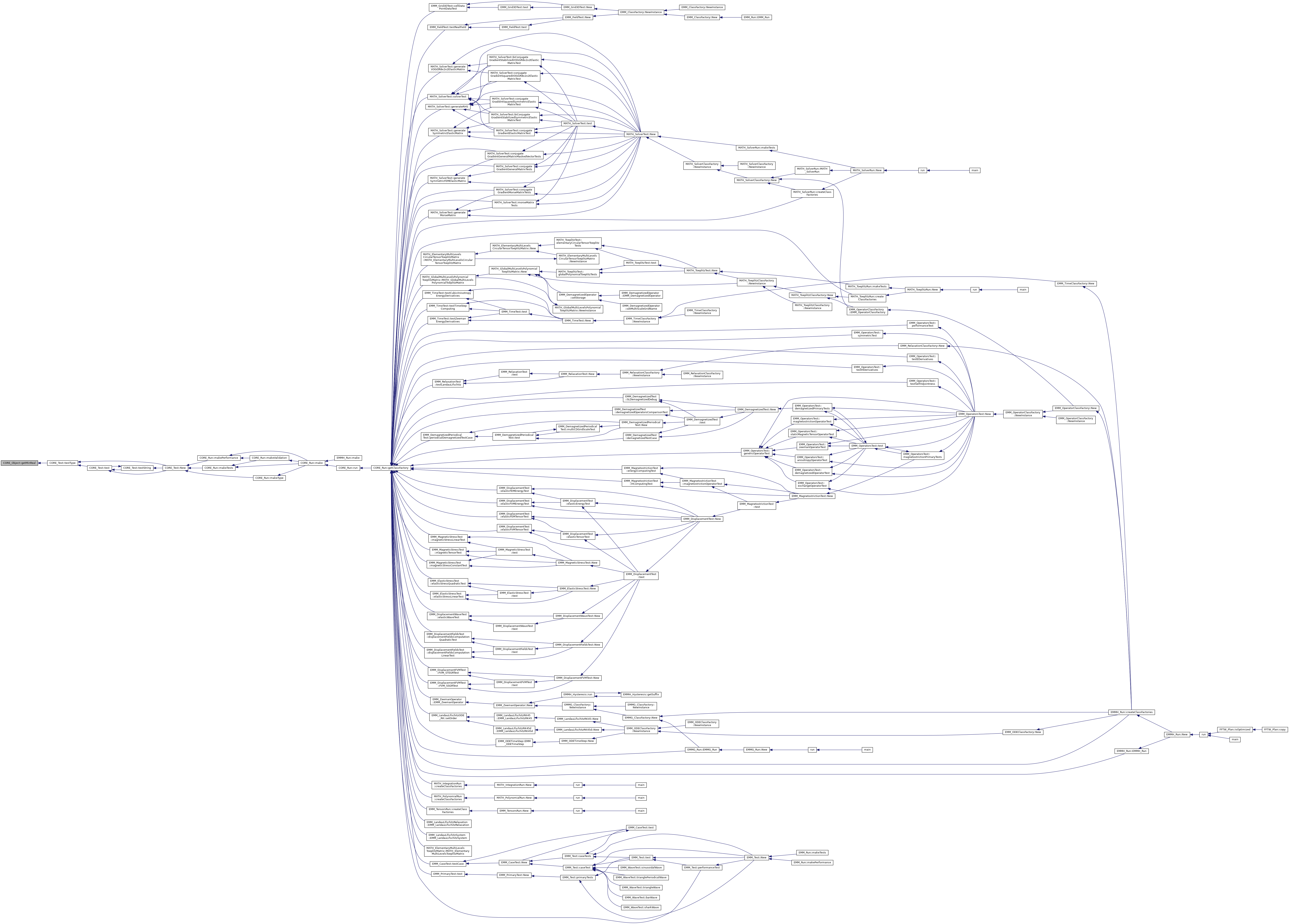
◆ getMinSInt()
|
inlinestaticinherited |
get the min value for tSInt type
- Returns
- the min value for tSInt type
Referenced by CORE_Test::testType().
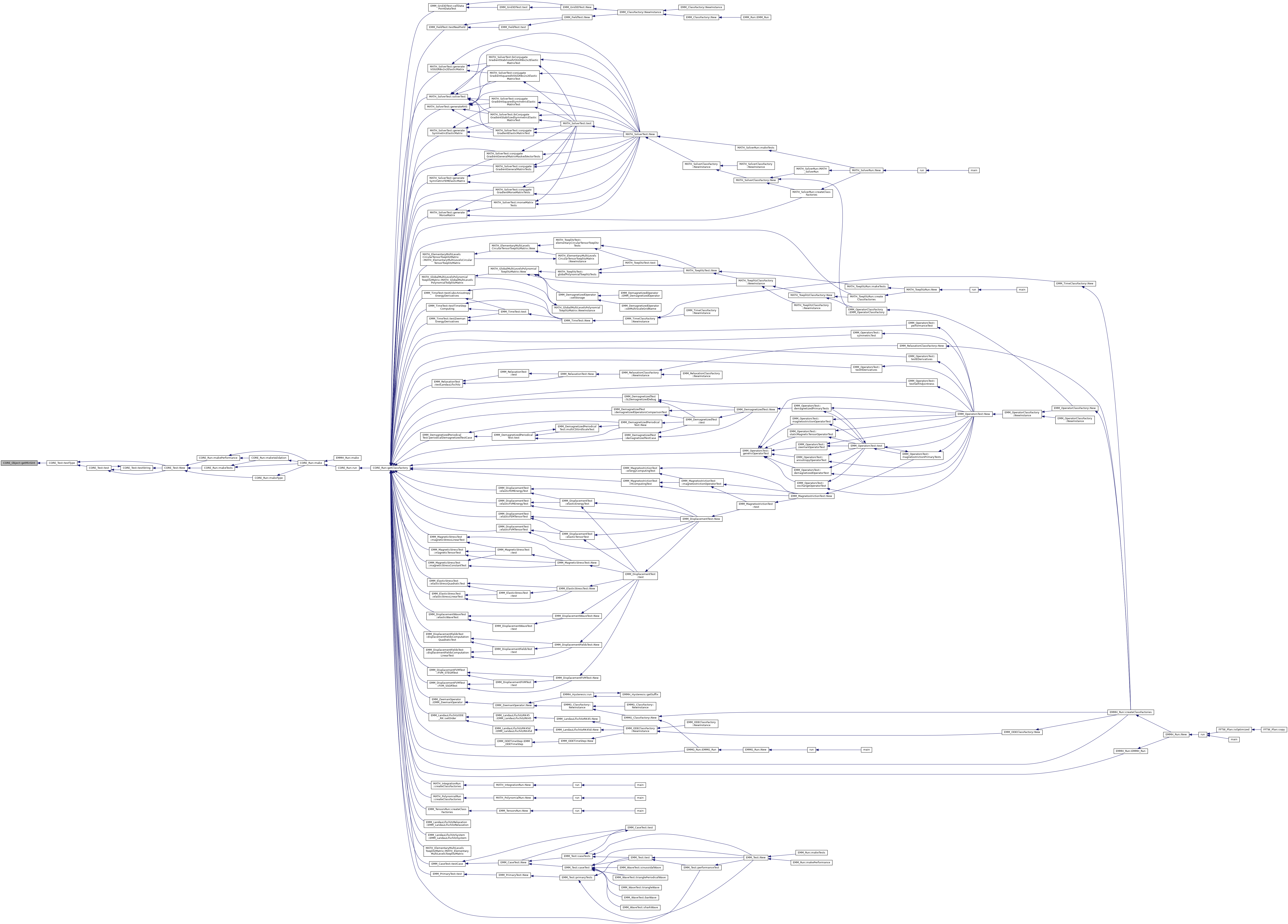
◆ getMinUChar()
|
inlinestaticinherited |
get the min value for tUChar type
- Returns
- the min value for tUChar type
Referenced by CORE_Test::testType().
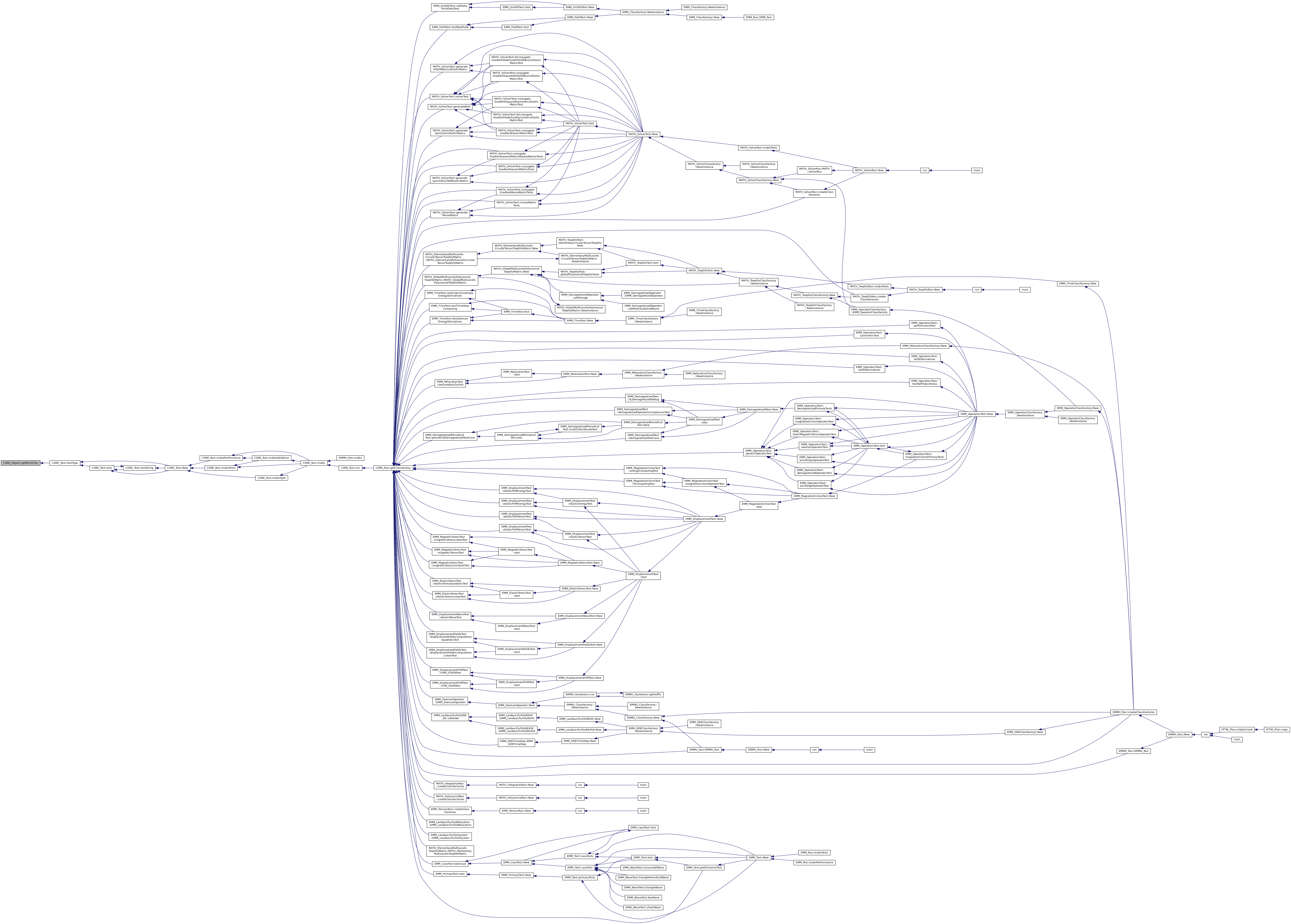
◆ getMinUIndex()
|
inlinestaticinherited |
get the min value for difference the array/vector indexing type
- Returns
- the min value for difference the array/vector indexing type
Referenced by CORE_Test::testType().
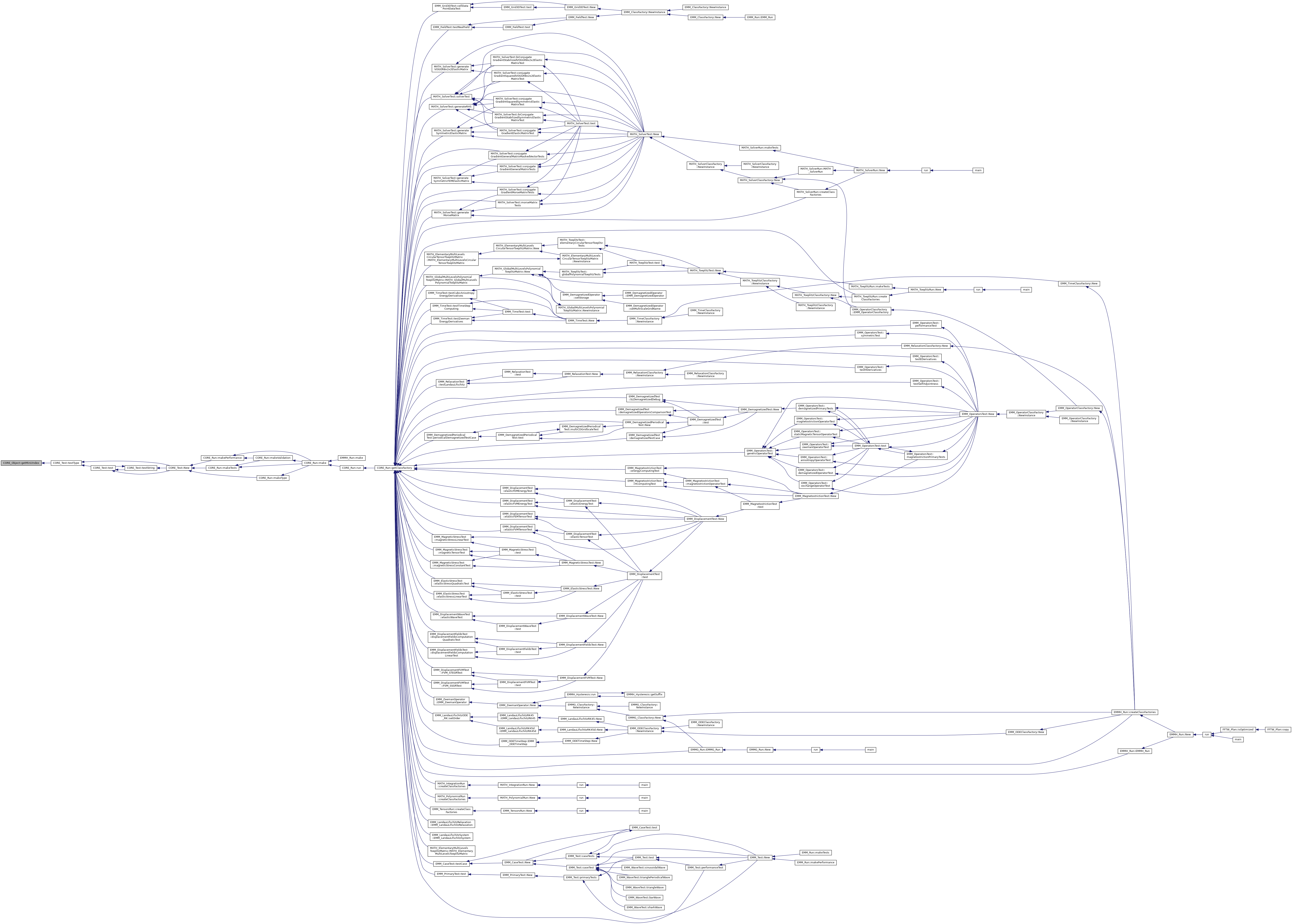
◆ getMinUInt()
|
inlinestaticinherited |
get the min value for tUInt type
- Returns
- the min value for tUInt type
Referenced by CORE_Test::testType().
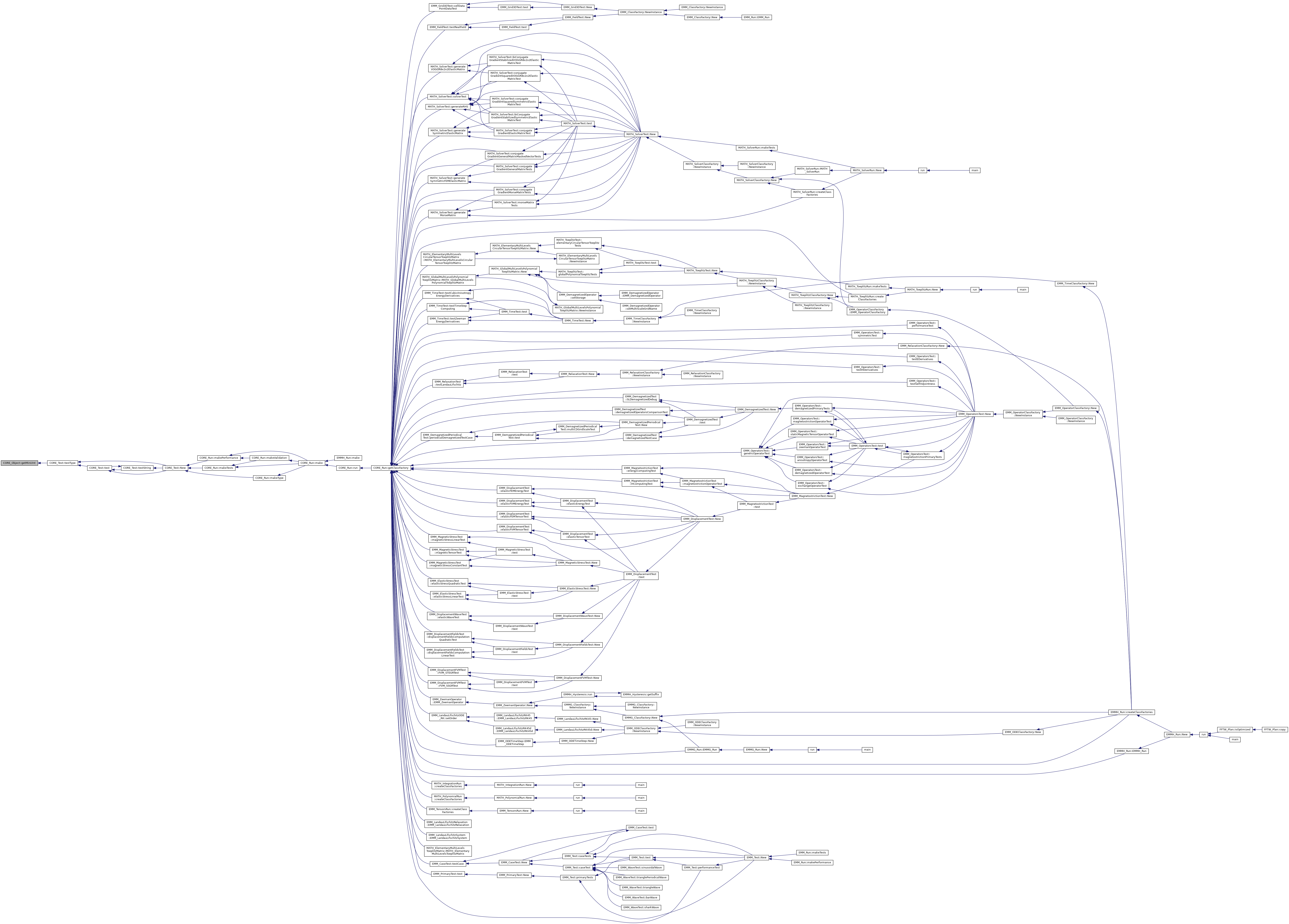
◆ getMinUInteger()
|
inlinestaticinherited |
get the min value for the unsigned integer type
- Returns
- the min value for the unsigned integer type
Referenced by CORE_Test::testType().

◆ getMinULInt()
|
inlinestaticinherited |
get the min value for tULInt type
- Returns
- the min value for tULInt type
Referenced by CORE_Test::testType().

◆ getMinULLInt()
|
inlinestaticinherited |
get the min value for tULLInt type
- Returns
- the min value for tULLInt type
Referenced by CORE_Test::testType().
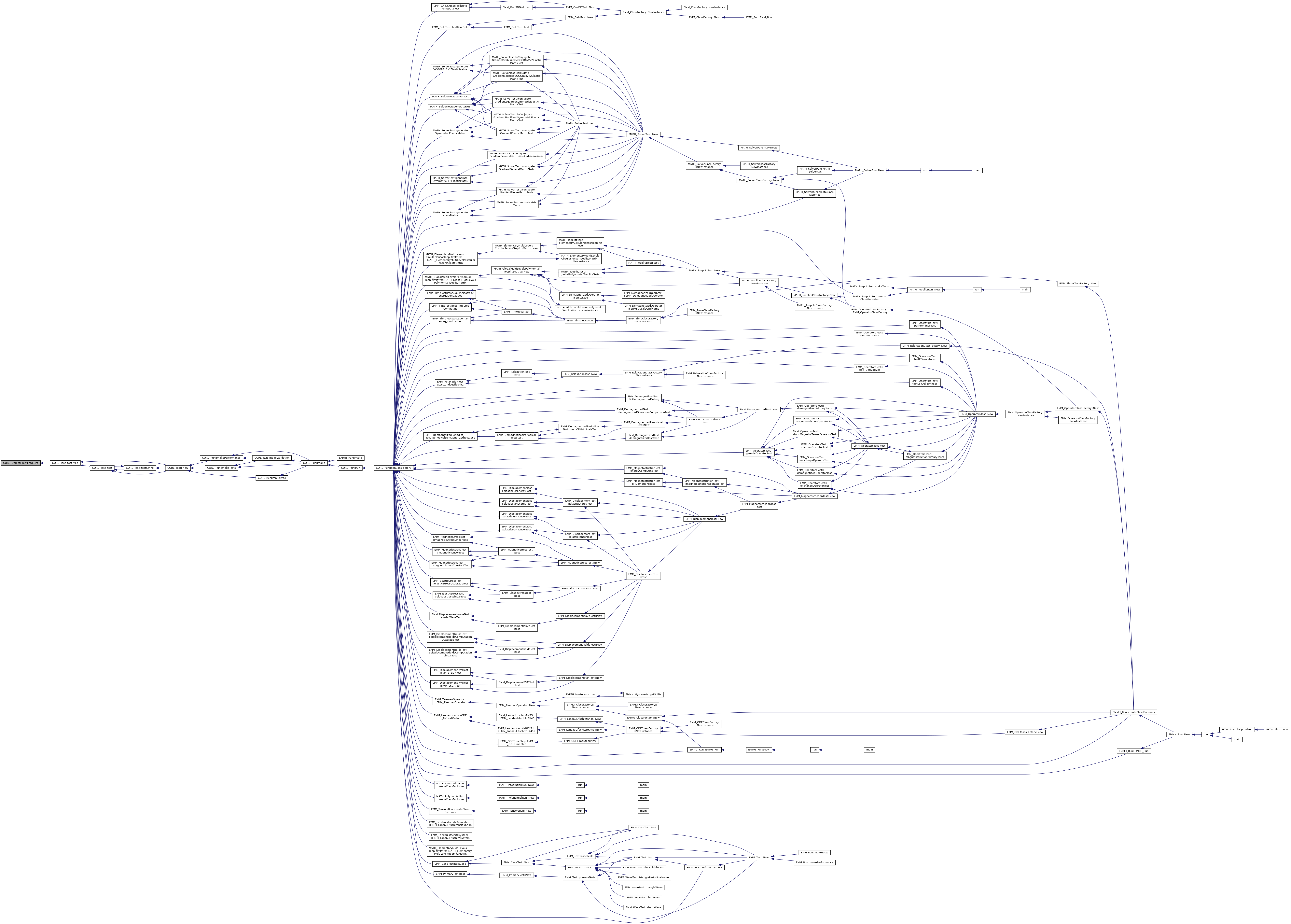
◆ getMinUSInt()
|
inlinestaticinherited |
get the min value for tUSInt type
- Returns
- the min value for tUSInt type
Referenced by CORE_Test::testType().
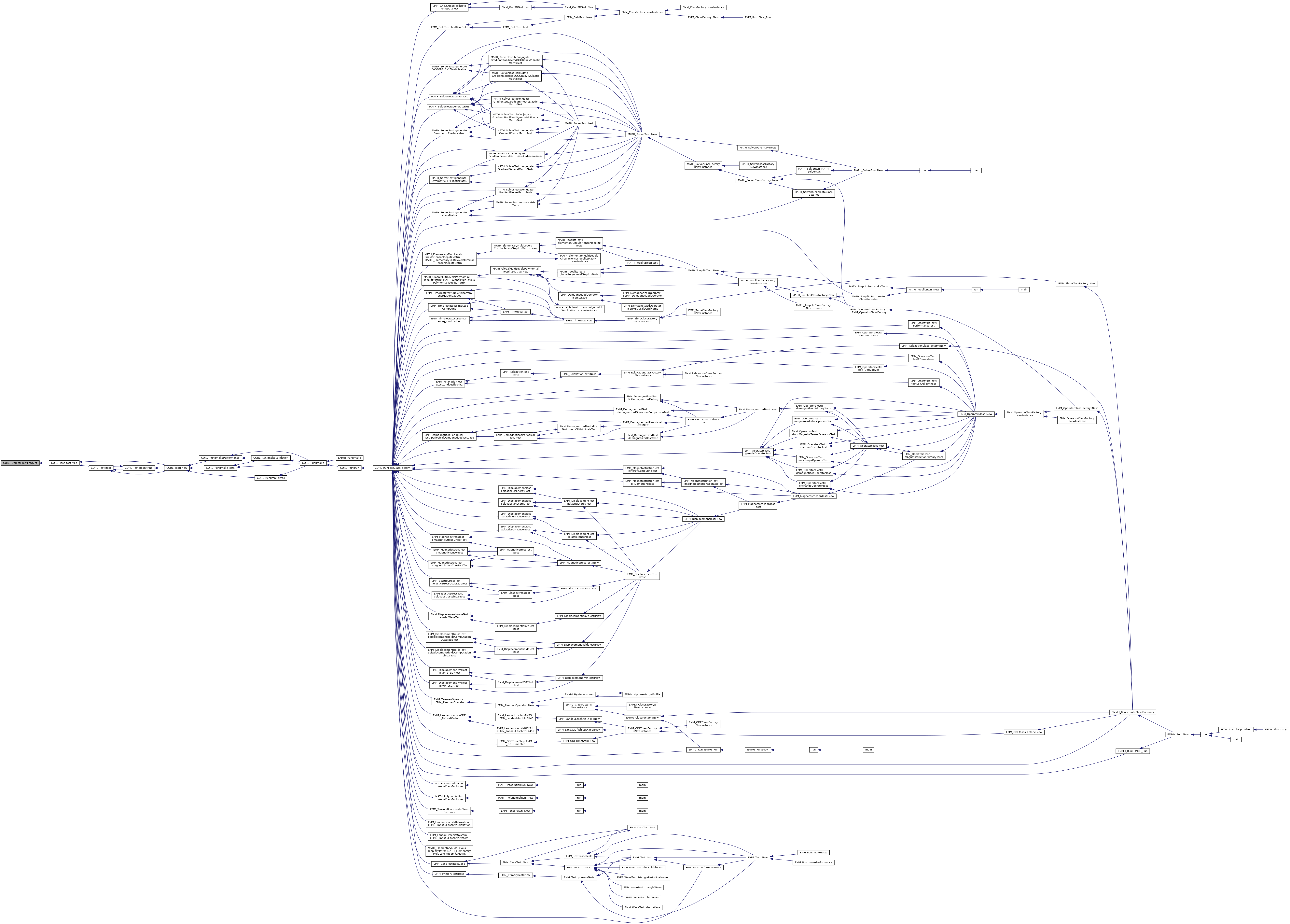
◆ getOut()
|
inlinestaticinherited |
◆ getPeriodicDirections() [1/2]
|
inlineinherited |
get the periodicity per direction
- Returns
- if the direction is periodic indexed by the index of the direction (x=0,y=1,z=2)
References EMM_MultiScaleGrid::mIsPeriodic.
Referenced by completeValuesOutsideFineGridByPeriodicityByExclusion(), EMMG_SLRPPeriodicMultiScale::computeMultiGridExcitationField(), EMMG_SLSDXPeriodicMultiScale::computeMultiGridExcitationField(), EMM_MultiScaleSDGrid::computeValuesOnShiftFineGrid(), and meanValuesFromFineToCoarseGrid().

◆ getPeriodicDirections() [2/2]
|
inlineinherited |
get the periodicity per direction
- Parameters
-
isXPeriodic : true if the x-direction is periodic isYPeriodic : true if the y-direction is periodic isZPeriodic : true if the z-direction is periodic
◆ getPointerAddress()
|
inlineinherited |
return the identity string of the object
- Returns
- the identity string of the object
References CORE_Object::pointer2String().

◆ getRealEpsilon()
|
inlinestaticinherited |
get the eps which is the difference between 1 and the least value greater than 1 that is representable.
- Returns
- the eps which is the difference between 1 and the least value greater than 1 that is representable.
Referenced by MATH_P4::solveP4De(), and CORE_Test::testType().
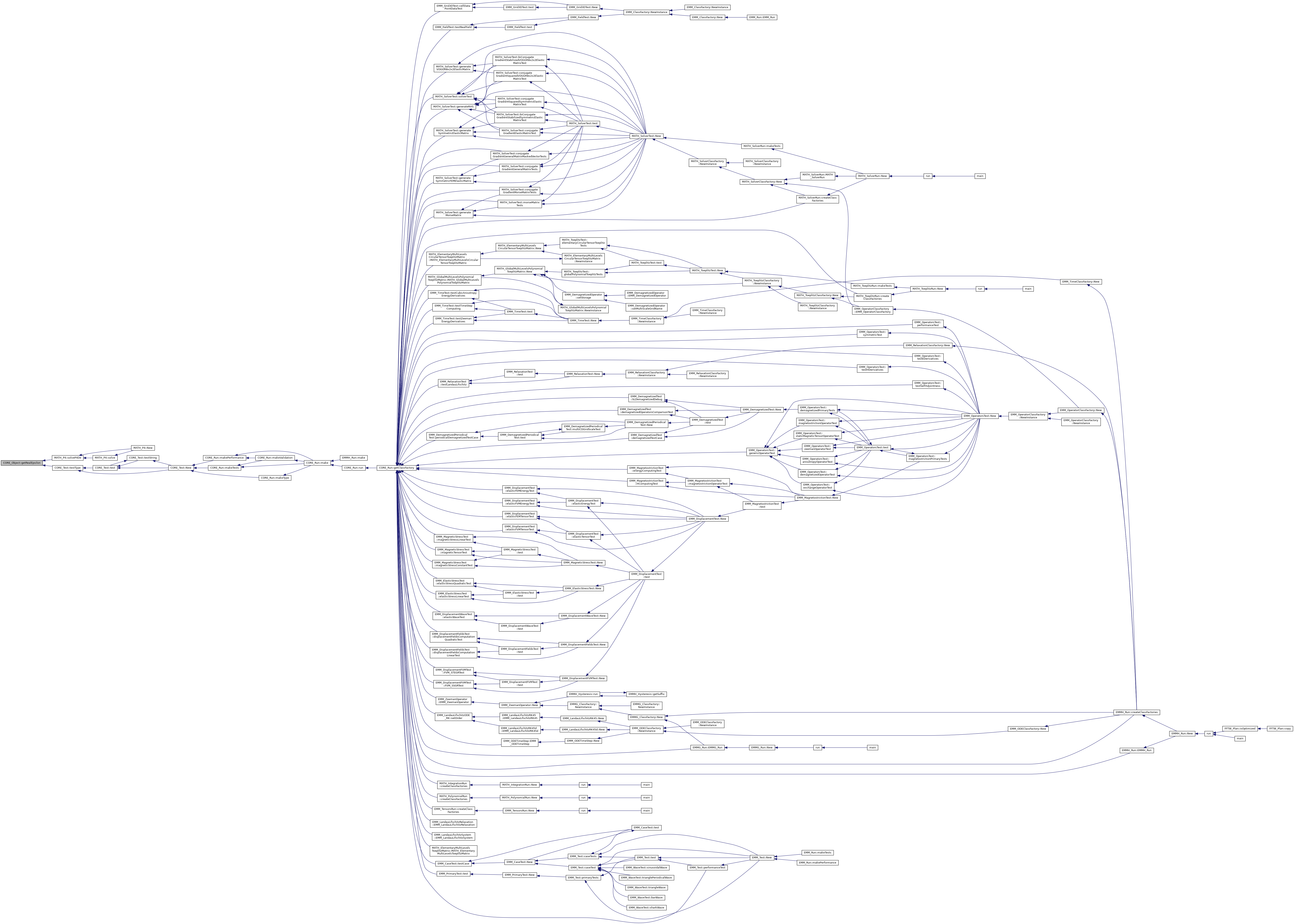
◆ getRealInfinity()
|
inlinestaticinherited |
get the infinity value
- Returns
- the inifinity value for the real type
Referenced by BrentFunction::BrentFunction(), EMM_OperatorsTest::compareDiscretizedData(), EMM_IterativeTimeStep::EMM_IterativeTimeStep(), EMM_SLElementaryDemagnetizedMatrix::Kxy(), NRFunction::NRFunction(), EMM_PolynomialInterpolationTimeStep::optimizeTimeFunction(), and CORE_Test::testType().
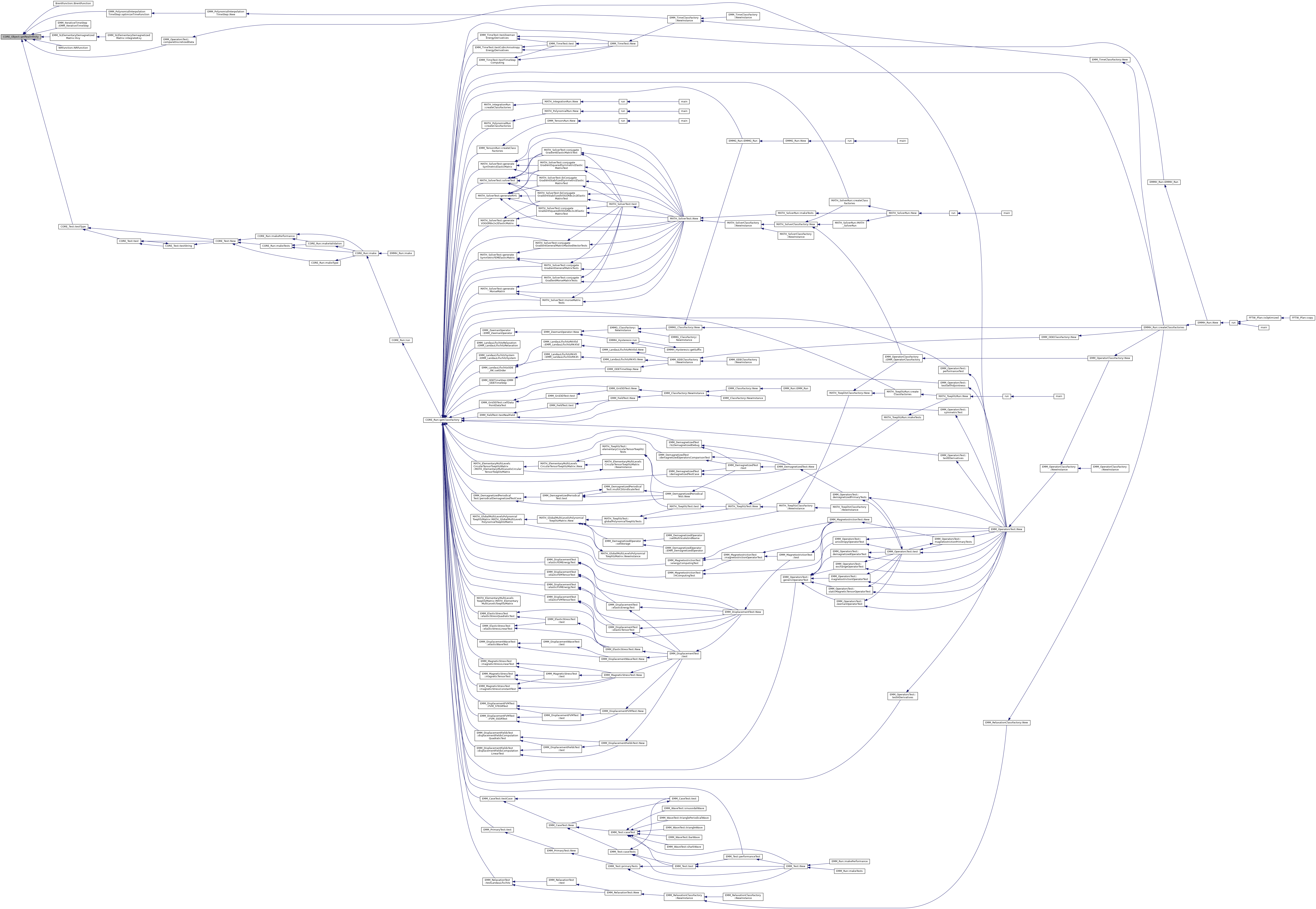
◆ getSegmentsNumber() [1/2]
|
inlineinherited |
get the segments number in all directions
- Parameters
-
Nx the segments number in x-direction Ny the segments number in y-direction Nz the segments number in z-direction
◆ getSegmentsNumber() [2/2]
|
inlineinherited |
get the segments number per dierction
- Returns
- the segments number by direction array indexed by the index of the direction (x=0,y=1,z=2)
References EMM_MultiScaleGrid::mN.
Referenced by addValuesFromCoarseGridToFinestGrid(), EMM_MultiScaleSDGrid::addValuesFromCoarseGridToFinestGrid(), EMM_MultiScaleSDGrid::addValuesFromShiftFineGridToFinestGrid(), completeValuesOutsideFineGridByPeriodicityByExclusion(), computeDemagnetizedExcitationFieldFromLevel(), EMMG_SLRPPeriodicMultiScale::computeMultiGridExcitationField(), EMMG_SLSDXPeriodicMultiScale::computeMultiGridExcitationField(), EMM_MultiScaleSDGrid::computeValuesOnShiftFineGrid(), EMM_MultiScaleSDGrid::computeZonalCenteredDemagnetizedFieldFromLevel(), EMM_MultiScaleSDGrid::computeZonalDemagnetizedFieldAndNextLevelMagnetizationField(), EMM_MultiScaleSDGrid::getShiftZone(), meanValuesFromFineToCoarseGrid(), EMM_MultiScaleSDGrid::meanValuesFromShiftFineGridToCoarseGrid(), resetValuesWithinCenteredZone(), and EMM_MultiScaleSDGrid::resetValuesWithinShiftZone().

◆ getSharedPointer() [1/2]
|
inlineinherited |
get the shared pointer of this class into p
- Parameters
-
p : shared pointer of the class This
Referenced by CORE_Map< Key, Value >::getSharedPointer(), CORE_ArrayList< tString >::getSharedPointer(), EMM_Array< tCellFlag >::getSharedPointer(), CORE_Array< tCellFlag >::getSharedPointer(), CORE_MorseArray< tUChar >::getSharedPointer(), CORE_Vector< T >::getSharedPointer(), and CORE_Object::printObjectsInMemory().
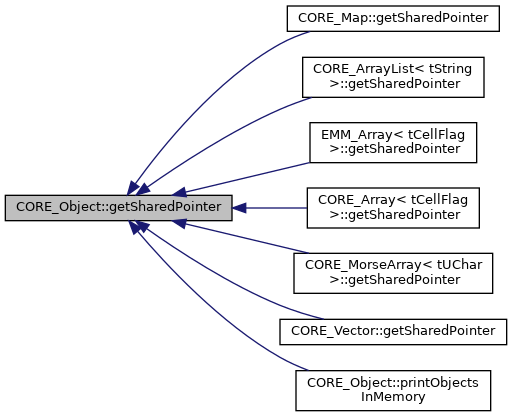
◆ getSharedPointer() [2/2]
|
inlineinherited |
get the shared pointer of this class into p
- Parameters
-
p : shared pointer of the class This
◆ getThread()
|
inlinestaticinherited |
get the profilier
- Returns
- the profiler
Referenced by MATH_MaskVector::add(), MATH_Vector::add(), EMM_DisplacementFEMOperator::addBoundaryElasticStress(), EMM_DisplacementFEMOperator::buildDataOnNeumannBoundaryFaces(), EMM_DisplacementFVMOperator::computeCineticEnergy(), EMM_DisplacementFVMOperator::computeElasticStress(), EMM_DisplacementFEMOperator::computeElasticStress(), EMM_DisplacementFVMOperator::computeElasticTensor(), EMM_DisplacementFEMOperator::computeElasticTensor(), EMM_StaticMagneticTensorOperator::computeEnergy(), EMM_CubicAnisotropyOperator::computeEnergy(), EMM_MagnetostrictionOperator::computeEnergy(), EMM_DisplacementOperator::computeEnergy(), EMM_AnisotropyOperator::computeEnergyWithMagneticExcitation(), EMM_DisplacementFVMOperator::computeEquilibriumMatrixDiagonalConditioner(), EMM_DisplacementFEMOperator::computeEquilibriumMatrixDiagonalConditioner(), EMM_FullExchangeOperator::computeMagneticExcitationField(), EMM_StaticMagnetostrictionOperator::computeMagneticExcitationField(), EMM_LinearAnisotropyOperator::computeMagneticExcitationField(), EMM_StaticMagneticTensorOperator::computeMagneticExcitationField(), EMM_CubicAnisotropyOperator::computeMagneticExcitationField(), EMM_MinimalExchangeOperator::computeMagneticExcitationField(), EMM_AnisotropyOperator::computeMagneticExcitationField(), EMM_MagnetostrictionOperator::computeMagneticExcitationField(), EMM_CubicAnisotropyOperator::computeMagneticExcitationFieldGradient(), EMM_AnisotropyOperator::computeMagneticExcitationFieldGradient(), EMM_DisplacementFVMOperator::computeMagneticStress(), EMM_DisplacementFEMOperator::computeMagneticStress(), EMM_OptimalTimeStep::computeOptimalTimeStep(), EMM_DisplacementFEMOperator::computeStressConstraintEnergy(), EMM_FullExchangeOperator::discretize(), EMM_MinimalExchangeOperator::discretize(), EMM_CondensedMassMatrix::discretize(), EMM_LinearAnisotropyOperator::discretize(), EMM_AnisotropyOperator::discretize(), EMM_DemagnetizedOperator::discretize(), EMMG_SLDemagnetizedOperator::discretize(), EMM_LandauLifschitzSystem::discretize(), MATH_Vector::divide(), MATH_MaskVector::dot(), MATH_Vector::dot(), EMM_4SymmetricTensors::doubleDot(), EMM_4Tensors::doubleDotCrossDoubleDotScalar(), EMM_4Tensors::doubleDotCrossProduct(), EMM_4Tensors::doubleDotCrossSquaredScalar(), EMM_4Tensors::doubleDotProduct(), MATH_Vector::init(), MATH_MaskVector::init(), EMM_LandauLifschitzODE_RK::integrateMagnetizationFieldAtTime(), EMM_DisplacementFVM_Interpolator::interpolateUAtVertices(), EMMG_SLDemagnetizedOperator::localAssembly(), EMM_DisplacementOperator::nullProjectionOnDirichletBoundary(), EMM_DisplacementOperator::periodicProjection(), EMM_2PackedSymmetricTensors::product(), EMM_CanonicalMassMatrix::product(), MATH_FullMatrix::product(), EMM_CondensedMassMatrix::product(), EMM_BlockMassMatrix::product(), MATH_MorseMatrix::product(), EMMG_SLDemagnetizedOperator::product(), EMM_DisplacementOperator::projectionOnDirichletBoundary(), EMM_LandauLifschitzSystem::resetOperatorsToInitialState(), EMM_DisplacementFVMOperator::setBoundaryFaceTypes(), FFTW_MultiDFTs::setFFT(), FFTW_MultiLevelsDFT::setFFT(), FFTW_MultiLevelsDFT::setLevels(), FFTW_MultiDFTs::setPlan(), FFTW_MultiLevelsDFT::setPlan(), EMM_CondensedMassMatrix::solve(), EMM_LandauLifschitzODE::solveODE(), EMM_4SymmetricTensors::squaredDoubleDot(), EMM_4Tensors::squaredDoubleDotCrossScalar(), EMM_4Tensors::squaredDoubleDotScalar(), EMM_CanonicalMassMatrix::symmetricDot(), EMM_CondensedMassMatrix::symmetricDot(), EMM_BlockMassMatrix::symmetricDot(), FFTW_Test::test(), MATH_SolverTest::test(), EMM_ODETest::testODE(), and EMM_Grid3D::updateLimitConditionOnPoints().

◆ getToeplitzMatrix()
|
inlineinherited |
get the toeplitz matrix
- Returns
- the toeplitz matrix
Referenced by computeDemagnetizedExcitationFieldFromLevel(), EMMG_SLSDXPeriodicMultiScale::computeLevelDemagnetizedField(), EMMG_SLRPPeriodicMultiScale::computeMultiGridExcitationField(), EMM_MultiScaleGrid::computeMultiGridExcitationField(), EMM_MultiScaleSDGrid::computeZonalCenteredDemagnetizedFieldFromLevel(), and EMM_MultiScaleSDGrid::computeZonalDemagnetizedFieldAndNextLevelMagnetizationField().

◆ getTypeName()
|
inlinestaticinherited |
◆ getZonalMagnetizationField()
|
inlineinherited |
get the magnetization field at zone
- Returns
- the magnetiaztion field at zone
References EMM_MultiScaleGrid::computeMultiGridExcitationField(), EMM_MultiScaleGrid::computeZonalCenteredDemagnetizedFieldFromLevel(), EMM_MultiScaleGrid::computeZonalDemagnetizedFieldAndNextLevelMagnetizationField(), EMM_MultiScaleGrid::resetBlockValues(), tBoolean, tDimension, tReal, tUIndex, and tUInteger.
Referenced by EMM_MultiScaleGrid::computeMultiGridExcitationField(), and EMM_MultiScaleSDGrid::initialize().
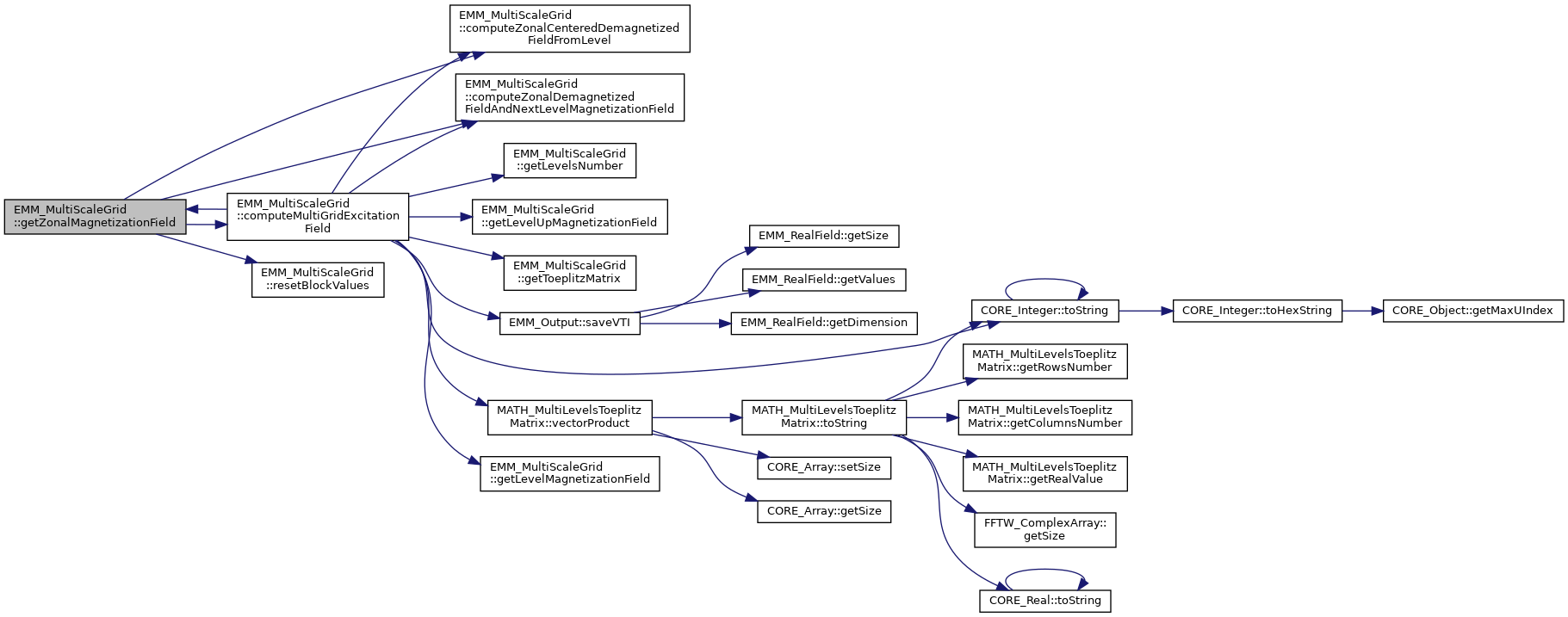

◆ initialize()
|
virtual |
set the discretization
- Parameters
-
dim dimension of the field Nx : number of segements along x-direction Ny : number of segements along y-direction Nz : number of segements along z-direction Px : periodicity along x-direction Py : periodicity along y-direction Pz : periodicity along z-direction l : number of levels
- initialize the fine grid bounds with a corse grid
- initialise the size of the M fields.
- compute the number of elements from the fine grid included in one element of the coarse grid.
Reimplemented from EMM_MultiScaleGrid.
Reimplemented in EMM_MultiScaleSDGrid.
References EMM_MultiScaleGrid::initialize().
Referenced by EMM_MultiScaleSDGrid::initialize(), and New().


◆ is32Architecture()
|
inlinestaticinherited |
return true if the machine is a 32 bits machine
- Returns
- true is the computing is done in a 32 bits machine
References CORE_Object::pointer2String(), CORE_Object::printObjectsInMemory(), and tString.
Referenced by CORE_Test::testType().


◆ is64Architecture()
|
inlinestaticinherited |
return true if the machine is a 64 bits machine
- Returns
- true is the computing is done in a 64 bits machine
Referenced by EMM_VTK::getVTKType(), and CORE_Test::testType().
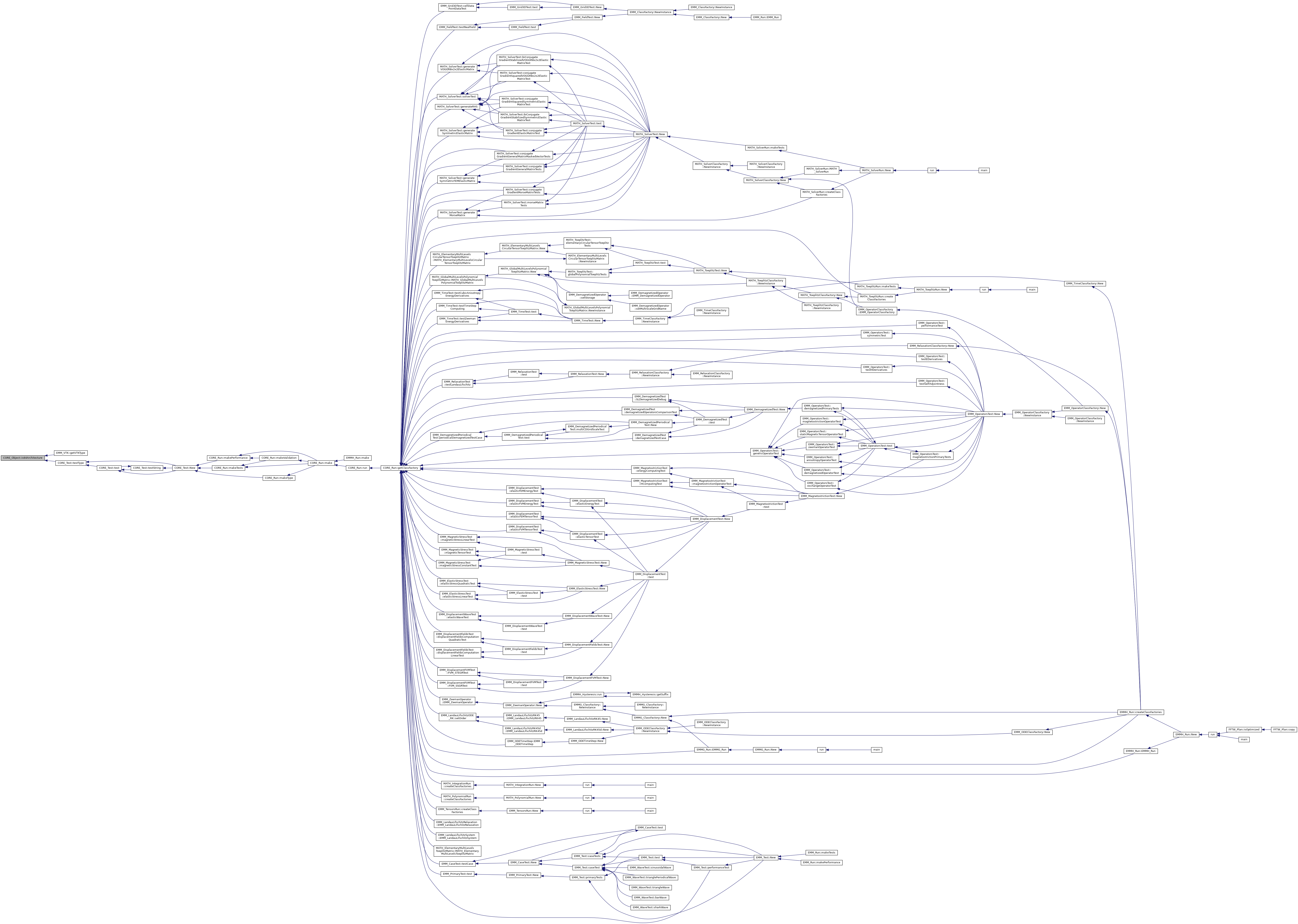
◆ isInstanceOf() [1/2]
|
inlineinherited |
test if the clas T is an instance of this class
- Returns
- true if the object is an instance of T
References null.
Referenced by MATH_ToeplitzTest::toeplitzTest().

◆ isInstanceOf() [2/2]
test if the object is an instance of className
- Parameters
-
name name of the class
- Returns
- true if the object is an instance of class Name
References CORE_Object::getIdentityString().

◆ isMemoryChecked()
|
inlinestaticinherited |
get if the memory checking is used
- Returns
- true: if the memory checking is used.
References CORE_Object::getClassName(), CORE_Object::mIsMemoryTesting, and tString.
Referenced by main().


◆ meanValuesFromFineToCoarseGrid()
| void EMM_MultiScaleCDGrid::meanValuesFromFineToCoarseGrid | ( | const tUIndex & | nCells, |
| const tDimension & | dim, | ||
| const tReal * | Mf, | ||
| tReal * | Ml | ||
| ) | const |
compute the field in a corse field from its fine grid.
- Parameters
the values of the field is meaned in the common part of the both grids as follow:
The values outside the fine grid  are set to 0 by defaut.
are set to 0 by defaut.
For each element of the fine grid (i,j,k), the corresponding element (I(i),J(j),K(k)) of the coarse grid is searched such that the center of the element (i,j,k) of the finest grid is inside the element (I,J,K) of the coarse grid.
The left boundary of the coarse grid is  when the origin is at the center of the grid
when the origin is at the center of the grid
The center of the cell i of the fine grid is  when the origin is at the center of the grid
when the origin is at the center of the grid
So, to search the cell of the coarse grid containing the center of the fine grid leads to  . We conclude that
. We conclude that


 .
.
So than  for all (i,j,k) such that I(i)=I, J(j)=J and K(k)=k
for all (i,j,k) such that I(i)=I, J(j)=J and K(k)=k
In the reverse way, we have  where
where  for
for  or
or  .
.
References EMM_MultiScaleGrid::getFineElementsNumberPerCoarseElement(), EMM_MultiScaleGrid::getPeriodicDirections(), EMM_MultiScaleGrid::getSegmentsNumber(), OMP_GET_THREAD_ID, OMP_GET_THREADS_NUMBER, OMP_PARALLEL_PRIVATE_SHARED_DEFAULT, tBoolean, tDimension, tInteger, tReal, tUCInt, tUIndex, and tUInteger.
Referenced by computeMagnetizationFieldAtNextLevel(), and New().
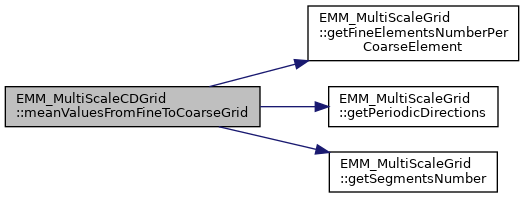

◆ New()
|
inlinestatic |
build a new instance of class
- Returns
- a shared pointer to This
References EMM_MultiScaleCDGrid(), initialize(), meanValuesFromFineToCoarseGrid(), tBoolean, tDimension, tReal, tUIndex, and tUInteger.
Referenced by EMM_DemagnetizedPeriodicalTest::multiCDGridScaleTest(), and EMMG_ClassFactory::NewInstance().


◆ out()
|
inlinestaticinherited |
get the output
- Returns
- the output stream
Referenced by EMM_Matter::adimensionize(), EMM_DisplacementFVMOperator::backup(), EMM_DisplacementOperator::backup(), MATH_ElementaryMultiLevelsToeplitzMatrix::buildSpectralVectorProjector(), EMM_Test::caseTest(), EMM_Test::caseTests(), EMM_MatterField::computeAnisotropyDirectionsField(), EMM_OptimalTimeStep::computeOptimalTimeStep(), MATH_MultiLevelsToeplitzMatrix::copy(), CORE_Exception::CORE_Exception(), EMM_MatterField::createAnisotropyOperator(), CORE_Run::createIO(), EMM_ElementaryTest::defaultBackupTest(), EMM_ElementaryTest::defaultTest(), MATH_MultiLevelsFFTToeplitzMatrix::diagonalize(), EMM_DisplacementFVMOperator::discretize(), EMM_MagnetostrictionOperator::discretize(), EMM_DisplacementFEMOperator::discretize(), EMM_4SymmetricTensors::doubleDot(), EMM_4Tensors::doubleDotCrossDoubleDotScalar(), EMM_TensorsTest::doubleDotCrossDoubleDotScalarTests(), EMM_4Tensors::doubleDotCrossProduct(), EMM_TensorsTest::doubleDotCrossProductTests(), EMM_4Tensors::doubleDotCrossSquaredScalar(), EMM_TensorsTest::doubleDotCrossSquaredScalarTests(), EMM_4Tensors::doubleDotProduct(), EMM_TensorsTest::doubleDotProductTests(), EMM_DisplacementWaveTest::elasticWaveTest(), EMM_Test::elementaryTests(), FFTW_Test::fftwTutorial(), MATH_IntegrationTest::gaussLegendreTest(), EMM_MagnetostrictionTest::HComputingTest(), EMM_DemagnetizedPeriodicalTest::HTest(), EMMH_HysteresisTest::hysteresisDefaultCycleTest(), EMM_TensorsTest::initializationTests(), EMM_MultiScaleGrid::initialize(), EMM_MultiScaleSDGrid::initialize(), EMM_MatterField::loadFromANIFile(), EMM_AnisotropyDirectionsField::loadFromFile(), EMM_Matter::loadFromFile(), EMM_Grid3D::loadFromGEOFile(), EMM_MatterField::loadFromLOCFile(), EMM_Array< tCellFlag >::loadFromStream(), EMM_Matter::loadFromStream(), EMM_Matter::loadMattersFromFile(), EMM_Run::loadSystemFromOptions(), EMM_ElementaryTest::magnetostrictionBackupTest(), CORE_Run::make(), EMMH_Run::makeHysteresis(), EMM_Run::makeRun(), CORE_Run::makeType(), EMM_ElementaryTest::optionsTest(), MATH_PolynomialTest::P4Tests(), EMM_Test::primaryTests(), EMM_LandauLifschitzSystem::printLog(), CORE_Run::printOptions(), EMM_2PackedSymmetricTensors::product(), EMMG_SLDemagnetizedOperator::projectionOnSpectralSpace(), CORE_Run::readOptionsFromCommandLine(), CORE_Test::readVectorTest(), EMM_DemagnetizedPeriodicalTest::relaxationTest(), EMM_DisplacementFVMOperator::restore(), EMM_DisplacementOperator::restore(), EMM_Input::restoreBackup(), EMMH_Hysteresis::run(), EMM_Output::save(), EMM_AnisotropyDirectionsField::saveToFile(), EMM_MatterField::saveToFile(), EMM_Grid3D::saveToGEOFile(), CORE_IOTest::searchTest(), EMMH_Hysteresis::setInitialMagnetizationField(), MATH_MultiLevelsToeplitzMatrix::setLevels(), EMM_4SymmetricTensors::squaredDoubleDot(), EMM_4Tensors::squaredDoubleDotCrossScalar(), EMM_TensorsTest::squaredDoubleDotCrossScalarTests(), EMM_4Tensors::squaredDoubleDotScalar(), EMM_TensorsTest::squaredDoubleDotScalarTests(), EMM_TensorsTest::squaredDoubleDotTests(), EMM_MatterTest::testAdimensionize(), EMM_MatterTest::testANIFile(), CORE_Test::testComplex(), CORE_Test::testDateWeek(), FFTW_Test::testDFT(), EMM_MatterTest::testIO(), EMM_ODETest::testODE(), CORE_Test::testOut(), CORE_Test::testReal(), EMM_FieldTest::testRealArray(), EMM_Grid3DTest::testSegment(), EMM_Grid3DTest::testThinSheet(), CORE_Test::testTime(), CORE_Test::testType(), MATH_FullMatrix::toString(), EMM_DemagnetizedPeriodicalTest::xyPeriodicalCubeSDGTest(), and EMM_DemagnetizedPeriodicalTest::xyPeriodicalSheetSDGTest().

◆ pointer2String()
|
staticinherited |
return the string representation of a pointer
- Parameters
-
obj : oject to get the string pointer
- Returns
- the string pointer of the object
References tString.
Referenced by CORE_Object::CORE_Object(), CORE_Object::getIdentityString(), CORE_Object::getPointerAddress(), CORE_Object::is32Architecture(), and CORE_Object::~CORE_Object().

◆ printObjectsInMemory() [1/2]
|
staticinherited |
print object in memory
- Parameters
-
f : output to print the objects in memory
References CORE_Object::getIdentityString(), CORE_Object::getSharedPointer(), CORE_Object::mIsMemoryTesting, CORE_Object::mObjects, and tInteger.

◆ printObjectsInMemory() [2/2]
|
inlinestaticinherited |
print object in memory in the standart output
Referenced by CORE_Object::is32Architecture(), and main().
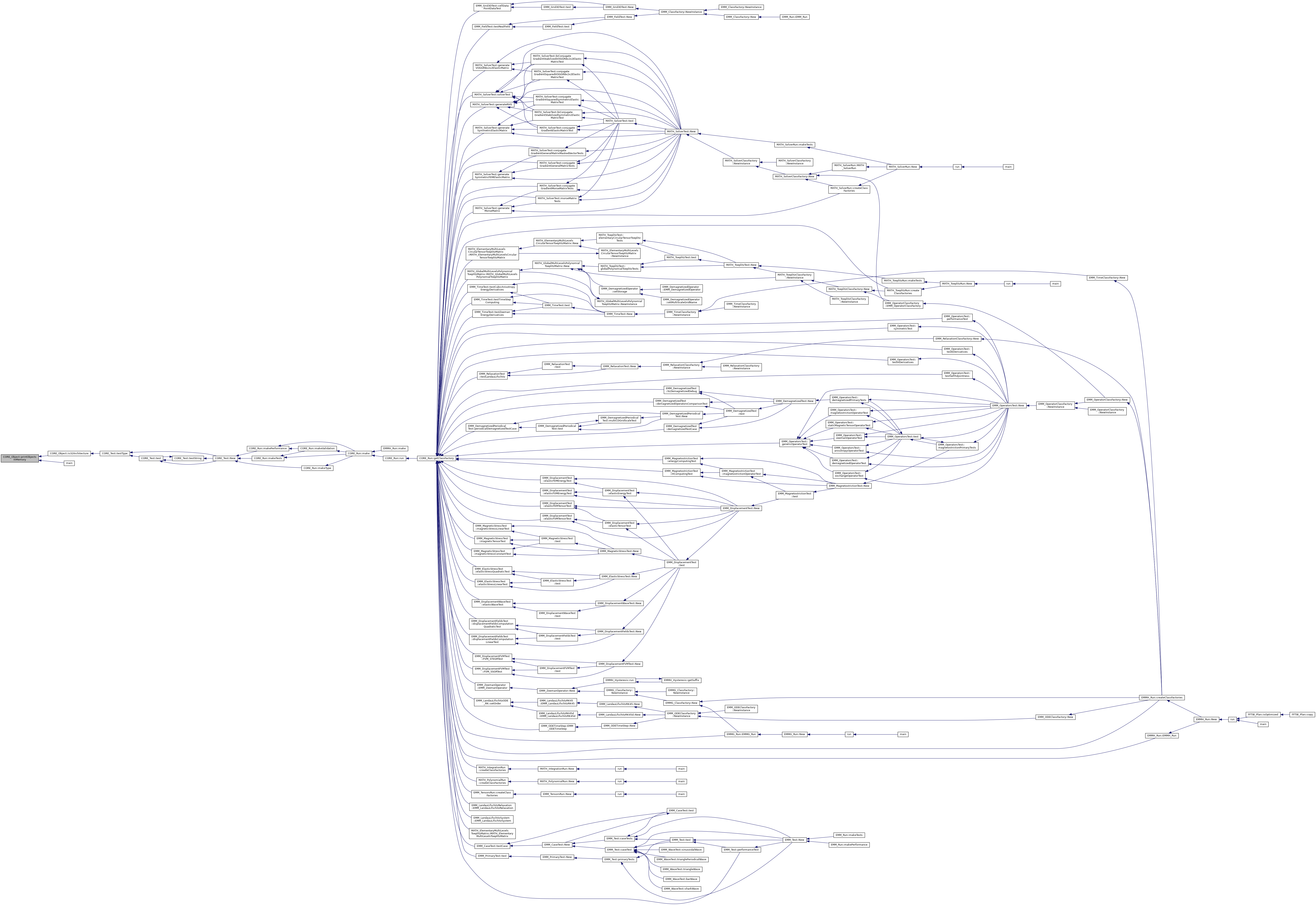
◆ resetBlockValues()
|
staticinherited |
reset the values in a block grid [iMin,iMax[x[jMin,jMax[x[kMin,kMax[ of dimension dim per point inside a grid of size [0,Nx[x[0,Ny[x[0,Nz[
- Parameters
-
[in] dim dimension of point [in] Nx : size of the grid in the x direction [in] Ny : size of the grid in the y direction [in] Nz : size of the grid in the z direction [in] iMin bounds if the block grid in [0,Nx[ [in] iMax bounds if the block grid in [0,Nx[ [in] jMin bounds if the block grid in [0,Ny[ [in] jMax bounds if the block grid in [0,Ny[ [in] kMin bounds if the block grid in [0,Nz[ [in] kMax bounds if the block grid in [0,Nz[ [in,out] M : field to reset values within the block grid
- Returns
- false if the block is empty
M is set to 0 on all points inside the grid [iMin,iMax[x[jMin,jMax[x[kMin,kMax[
References null, OMP_PARALLEL_PRIVATE_SHARED_DEFAULT, tReal, tUIndex, and tUInteger.
Referenced by EMM_MultiScaleGrid::getZonalMagnetizationField(), resetValuesWithinCenteredZone(), and EMM_MultiScaleSDGrid::resetValuesWithinShiftZone().

◆ resetOut()
|
inlinestaticinherited |
◆ resetThread()
|
inlinestaticinherited |
◆ resetValuesWithinCenteredZone()
| tBoolean EMM_MultiScaleCDGrid::resetValuesWithinCenteredZone | ( | const tUIndex & | nCells, |
| const tDimension & | dim, | ||
| tReal * | Mz | ||
| ) | const |
References EMM_MultiScaleGrid::getSegmentsNumber(), EMM_MultiScaleGrid::resetBlockValues(), tInteger, and tUInteger.
Referenced by completeValuesOutsideFineGridByPeriodicity(), computeDemagnetizedExcitationFieldFromLevel(), and EMM_MultiScaleSDGrid::computeZonalCenteredDemagnetizedFieldFromLevel().


◆ setIsMemoryChecked()
|
inlinestaticinherited |
set if the memory checking is used
- Parameters
-
v : true to check memory
Referenced by main().

◆ setOut()
|
inlinestaticinherited |
◆ setThis()
|
inlineprotectedinherited |
set this weak shared pointer called toDoAfterThis setting method
- Parameters
-
p : shared pointer of the class This
References CORE_Object::toDoAfterThisSetting().

◆ setThread()
|
inlinestaticinherited |
set the thread
- Parameters
-
thread the shared pointer to the thread
References null.
Referenced by EMM_Run::EMM_Run(), EMM_TensorsRun::EMM_TensorsRun(), and MATH_SolverRun::MATH_SolverRun().

◆ setToeplitzMatrix()
|
inlineinherited |
setthe toeplitz associated matrix
- Parameters
-
toeplitz the toeplitz matrix to set
References EMM_MultiScaleGrid::computeLevelsNumber(), EMM_MultiScaleGrid::initialize(), tBoolean, tDimension, and tUInteger.

◆ SP_OBJECT()
|
private |
◆ toDoAfterThisSetting()
|
inlineprotectedvirtualinherited |
method called after the setting of the shared pointer this method can only be called once.
Reimplemented from CORE_Object.
Reimplemented in EMM_DisplacementOperator, EMM_DisplacementFVMOperator, EMM_GaussLegendreRelaxation, and EMM_GradGaussLegendreRelaxation.
Referenced by EMM_GaussLegendreRelaxation::toDoAfterThisSetting(), and EMM_DisplacementOperator::toDoAfterThisSetting().

◆ toString()
|
virtualinherited |
return the class information in a tString
Reimplemented from CORE_Object.
Reimplemented in EMMG_SLPeriodicMultiScale.
References CORE_Object::getIdentityString().
Referenced by EMM_MultiScaleGrid::getLevelComputationsNumber().


Member Data Documentation
◆ Gamma
|
staticinherited |
◆ Mu0
|
staticinherited |
Referenced by EMM_MatterField::adimensionize(), EMM_MagnetostrictionOperator::adimensionize(), EMM_Matter::adimensionize(), EMM_CubicAnisotropyOperator::ComputeMagneticExcitation(), EMM_CubicAnisotropyOperator::computeMagneticExcitationField(), EMM_CubicAnisotropyOperator::computeMagneticExcitationFieldGradient(), EMM_CubicAnisotropyOperator::ComputeMagneticExcitationGradient(), EMM_Test::createMatters(), EMM_MatterField::getElasticTensorAdimensionizedParameter(), and EMM_MatterTest::testAdimensionize().
◆ NULL_VALUE
|
staticinherited |
Referenced by EMM_DisplacementFVM_VOGGROperator::computeGradAlmostNullUAtCellByOstrogradskiGreenIntegration(), EMM_DisplacementFVM_VTEGROperator::computeGradAlmostNullUAtCellByTaylorExpansionWithNeumannInterpolation(), EMM_DisplacementFVM_SSGROperator::computeGradAlmostNullUAtFaceByStokesIntegration(), EMM_DisplacementFVM_VOGGROperator::computeGradAlmostNullUAtNextCellByOstrogradskiGreenIntegration(), EMM_DisplacementFVM_VTEGROperator::computeGradUAtCellByTaylorExpansionWithNeumannInterpolation(), EMM_DisplacementFVM_VGROperator::computeGradUAtFace(), EMM_DisplacementFVM_SSGROperator::computeGradUAtFaceByStokesIntegration(), EMM_DisplacementFVM_STEGROperator::computeGradUAtFaceByTaylorExpansion(), EMM_DisplacementFVM_Interpolator::interpolateUAtEdge(), and EMM_DisplacementFVM_Interpolator::interpolateUAtVertices().
◆ SAVE_H_M_AT_LEVEL_1
|
staticinherited |
◆ X
|
staticinherited |
◆ Y
|
staticinherited |
Referenced by EMMG_SLSDXPeriodicMultiScale::computeMultiGridExcitationField(), EMMG_RealField::fitToSize(), EMM_MassMatrix::getElementVolume(), EMM_CanonicalMassMatrix::isSymmetric(), EMM_BlockMassMatrix::product(), EMM_CondensedMassMatrix::product(), EMM_RealField::setValue(), EMM_CanonicalMassMatrix::solve(), EMM_BlockMassMatrix::solve(), EMM_BlockMassMatrix::toString(), and EMMG_RealField::wedge().
◆ Z
|
staticinherited |
The documentation for this class was generated from the following files:



























 1.8.13
1.8.13